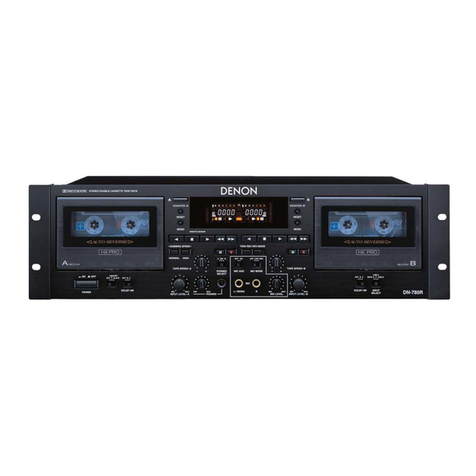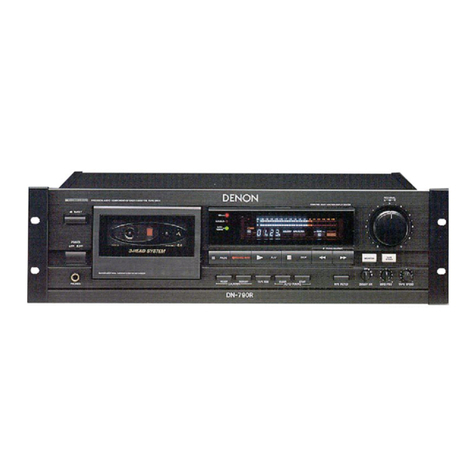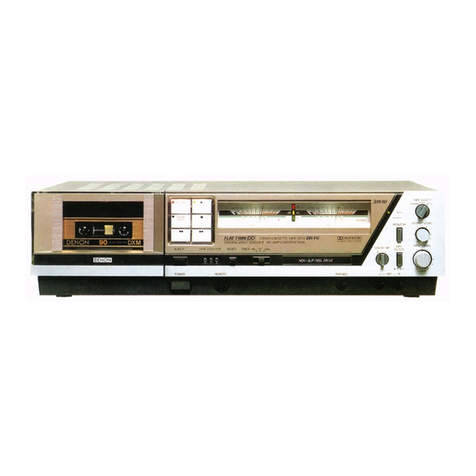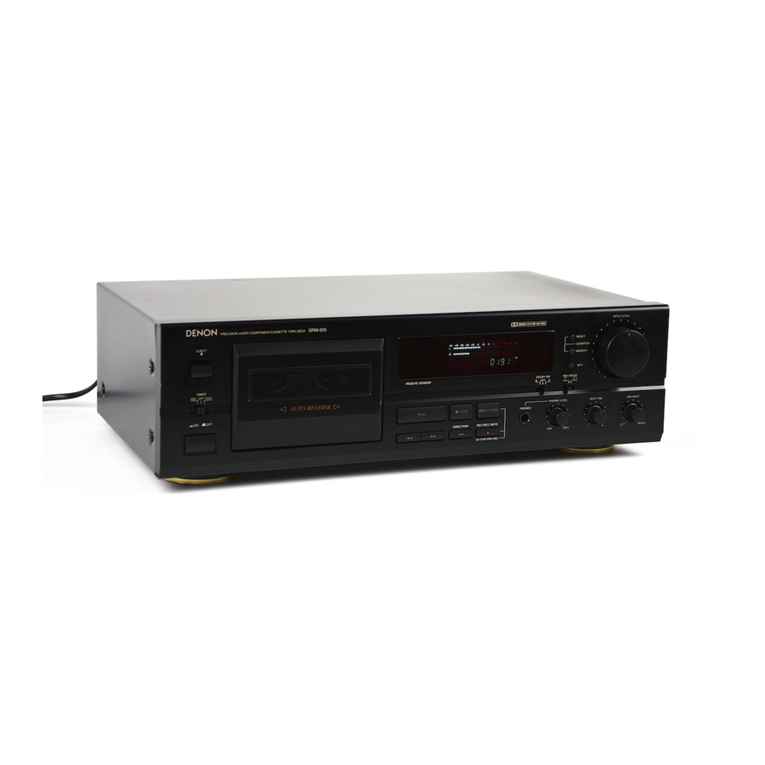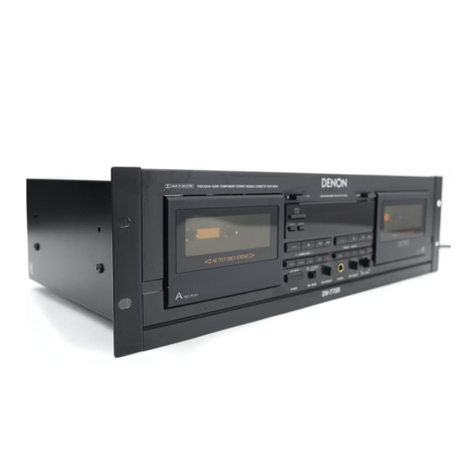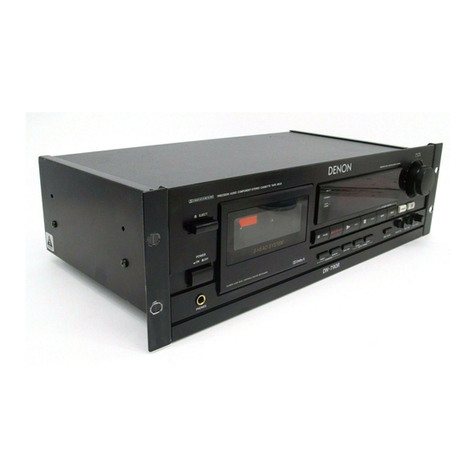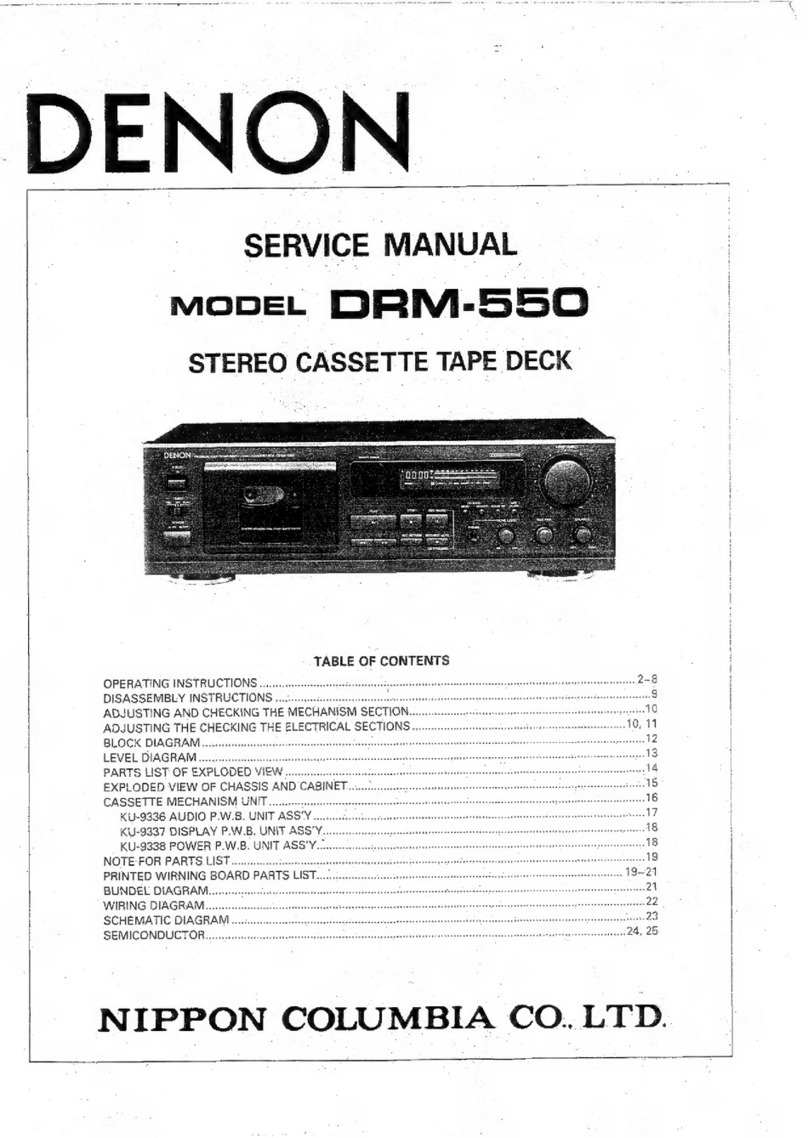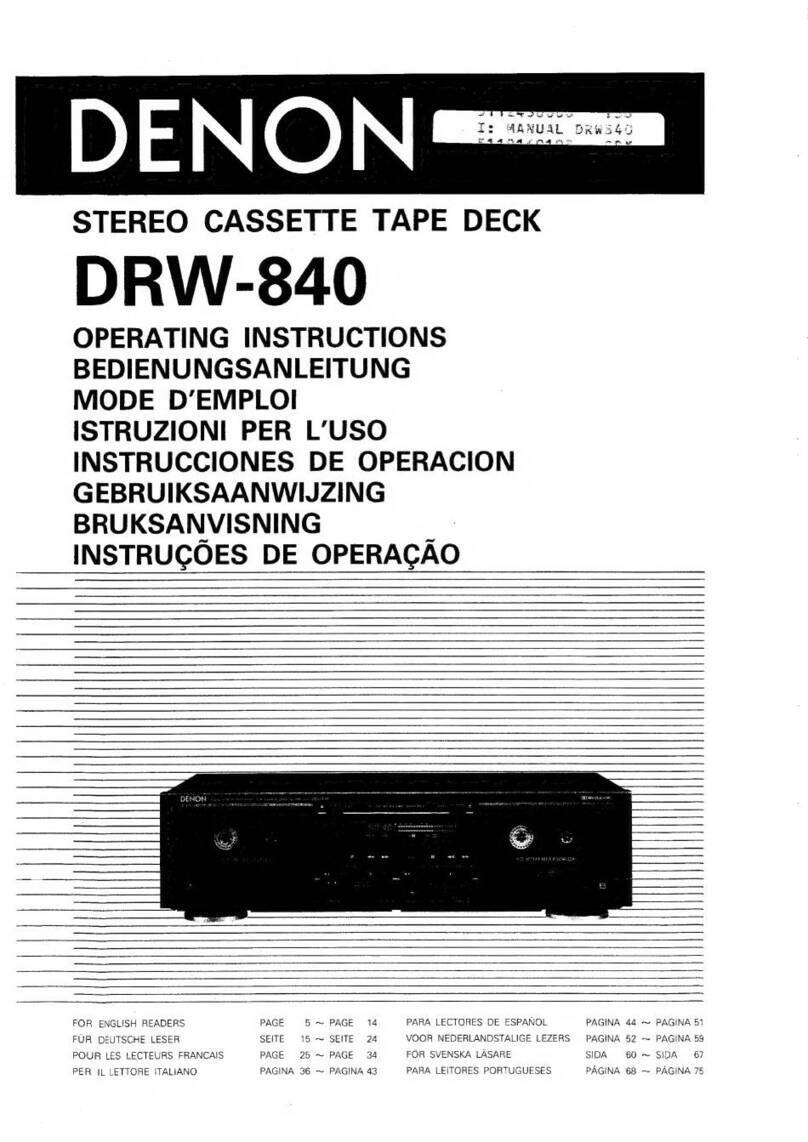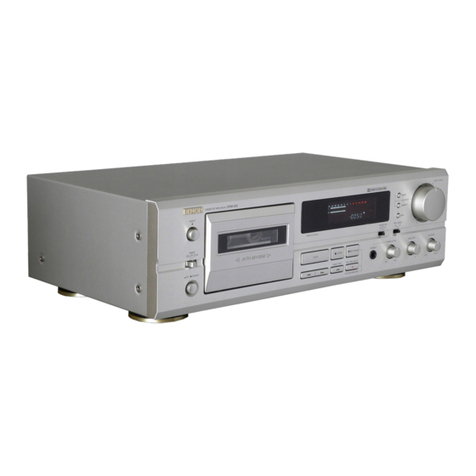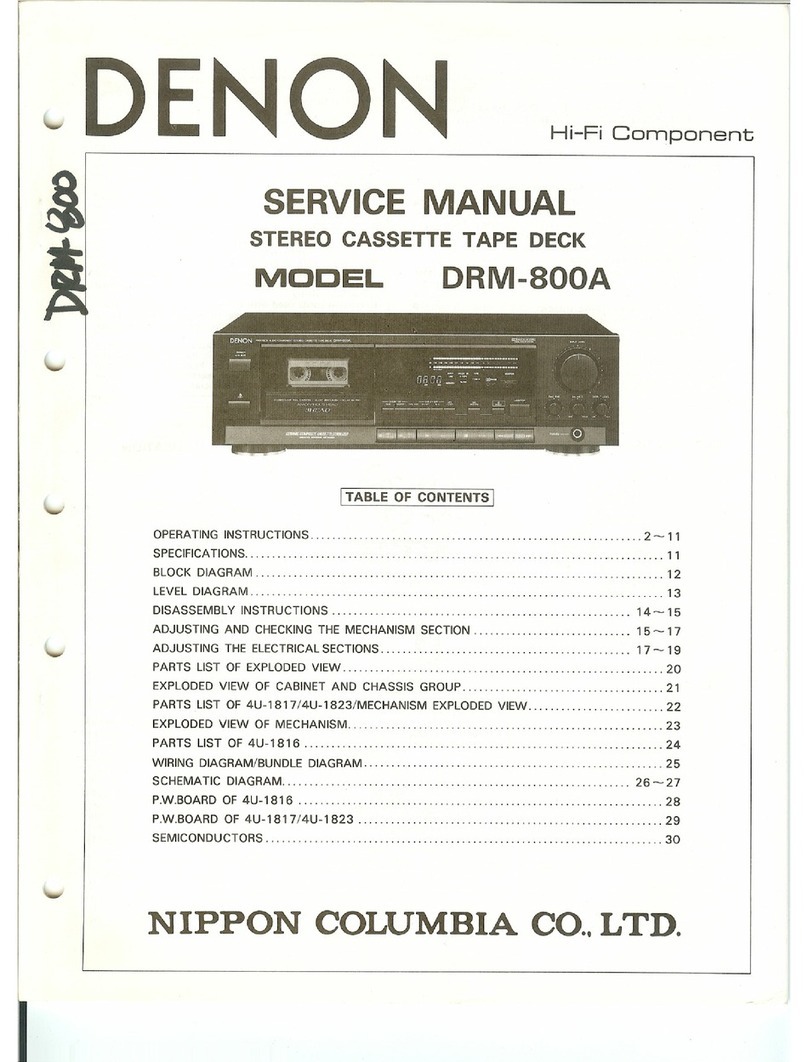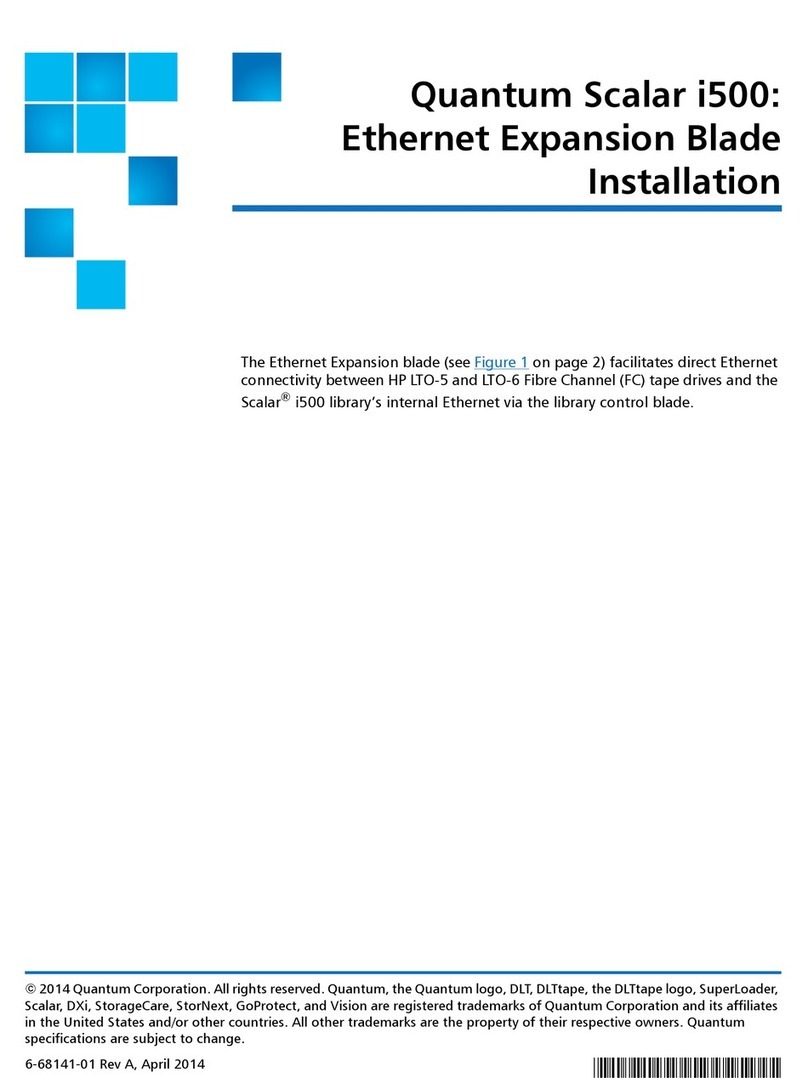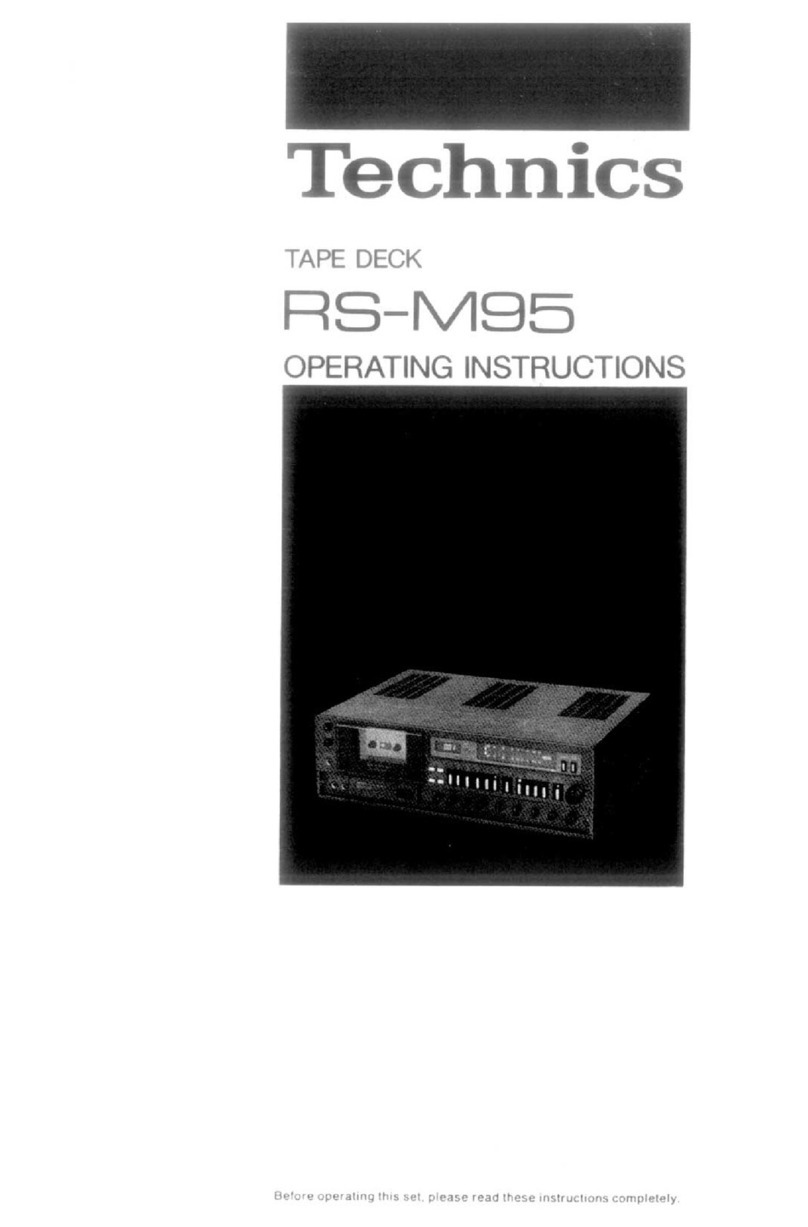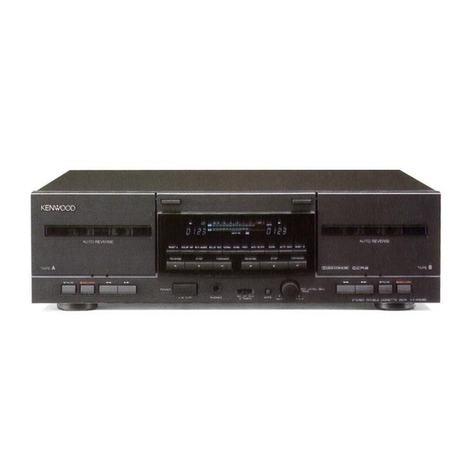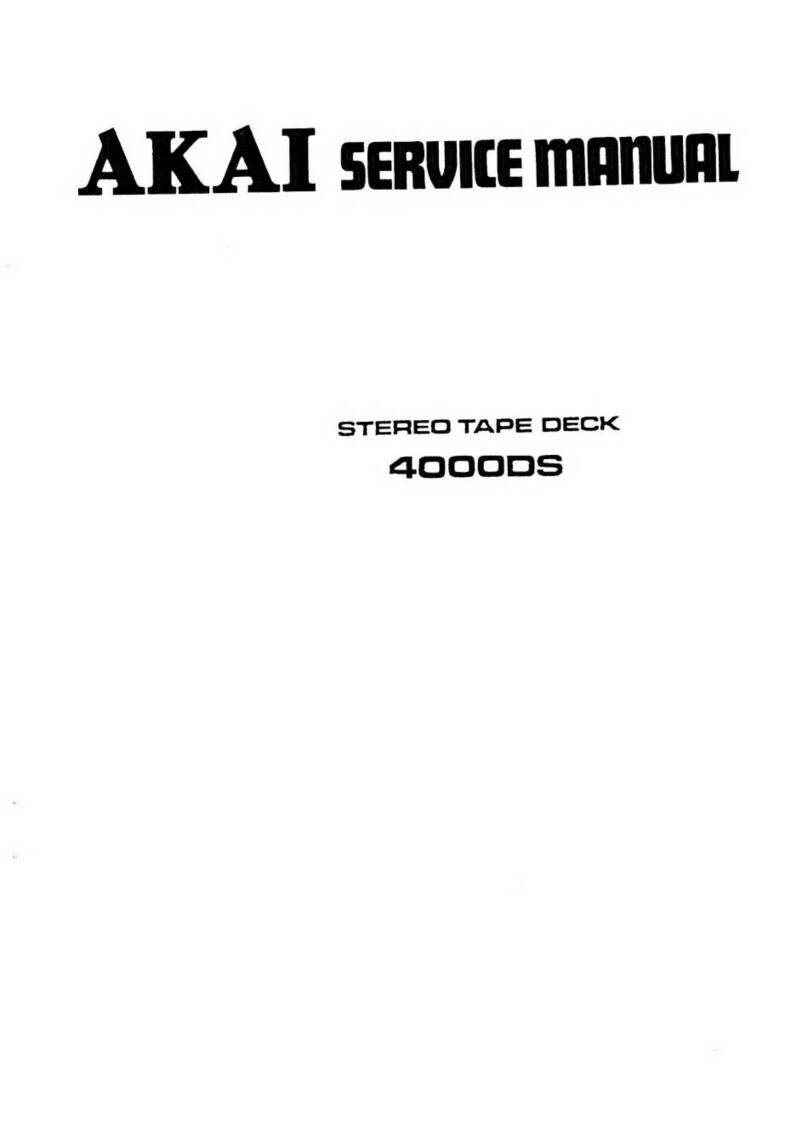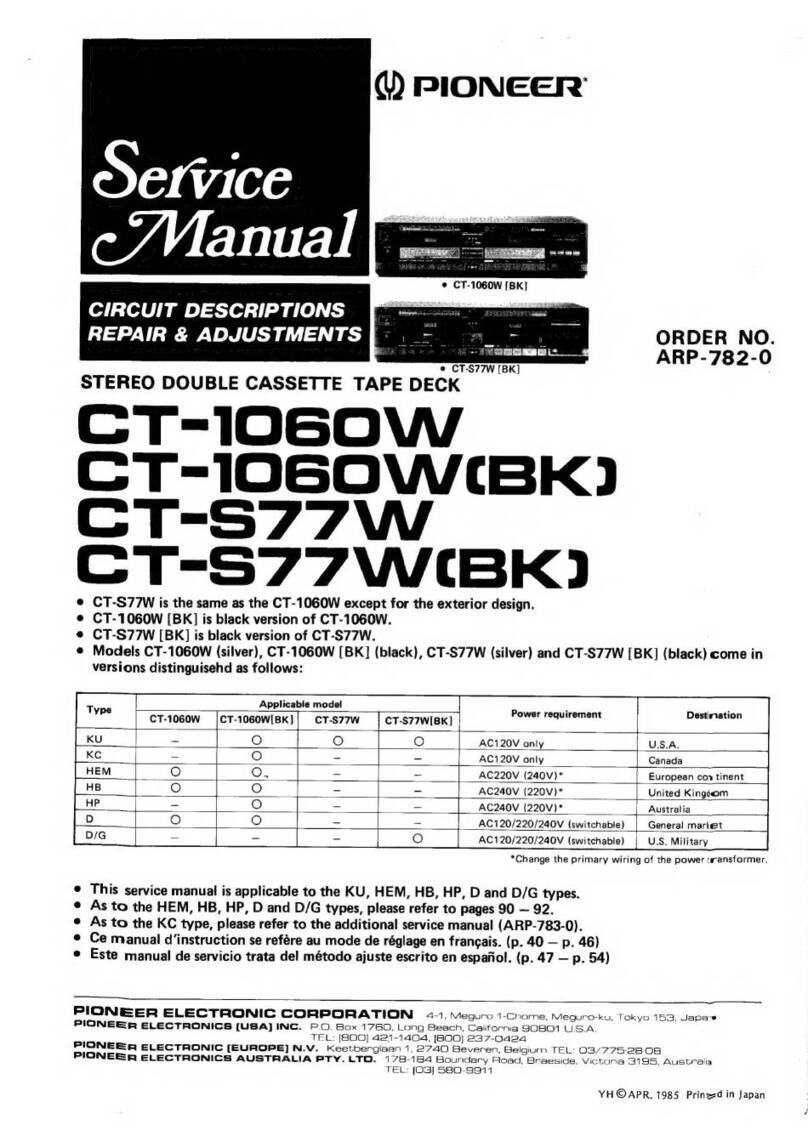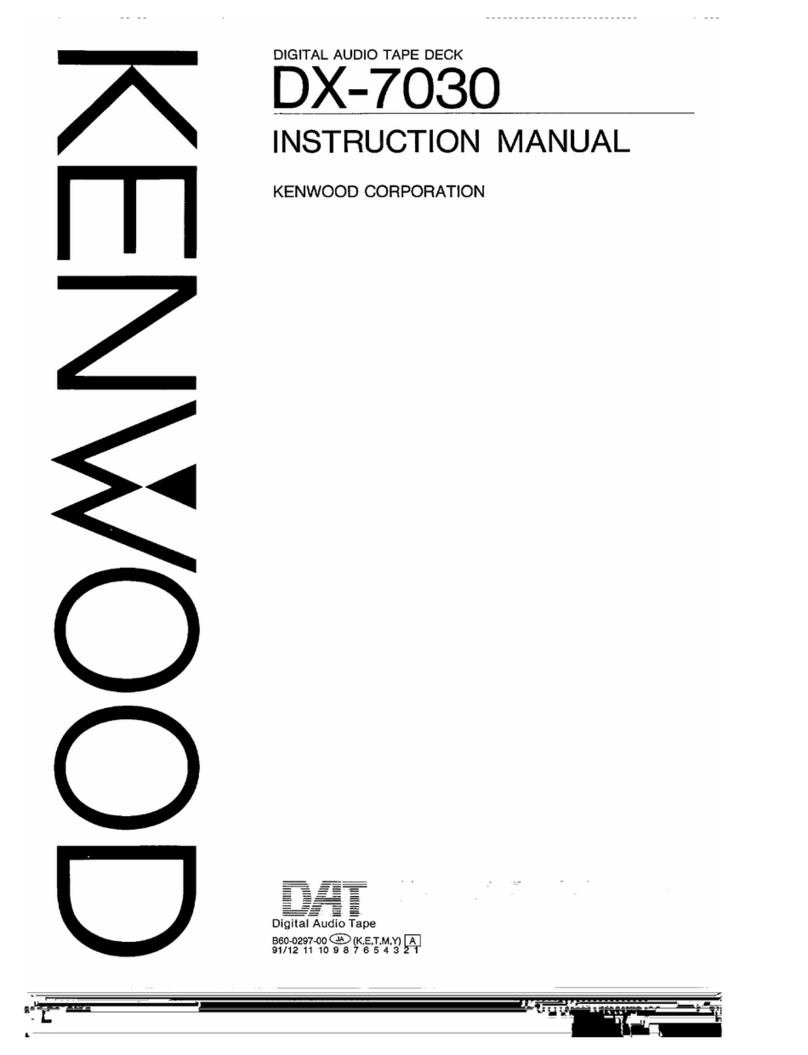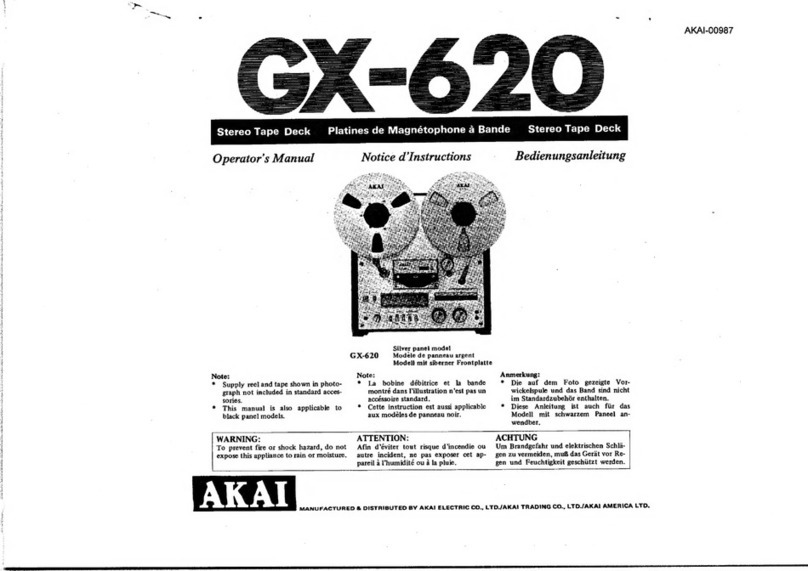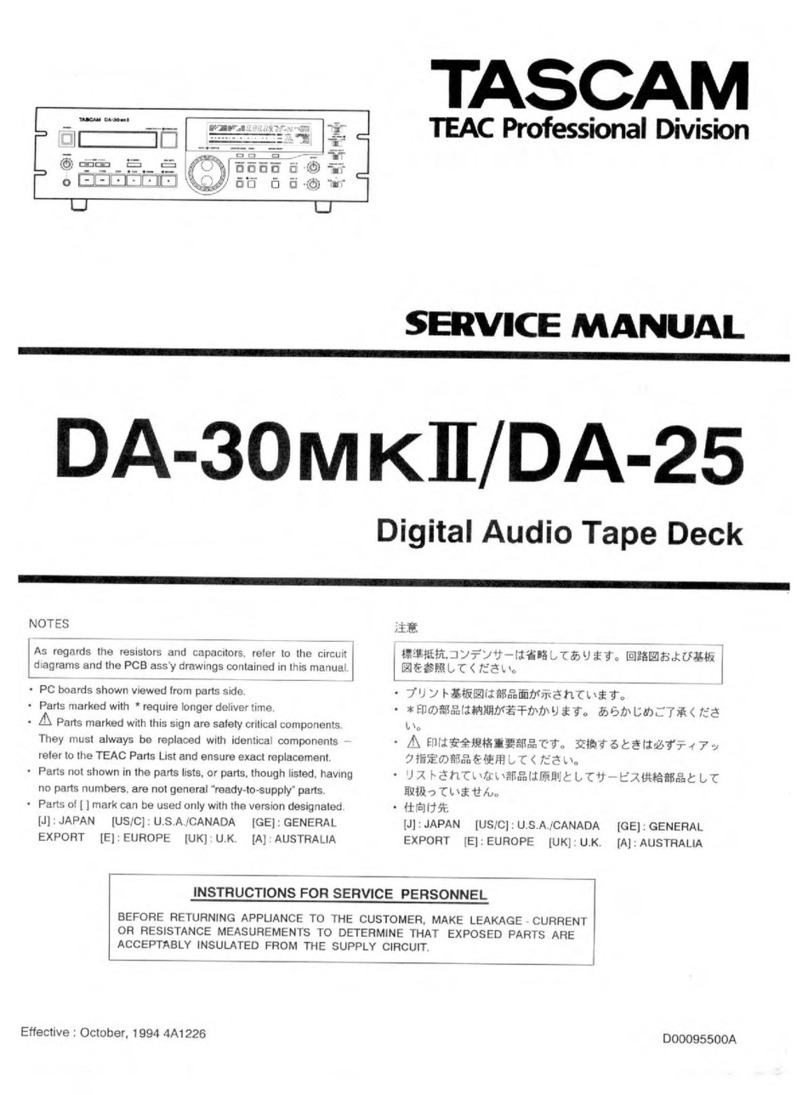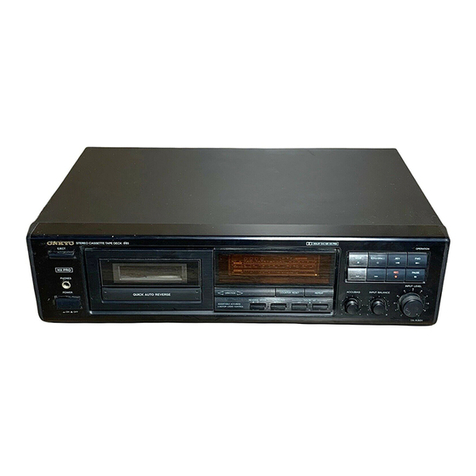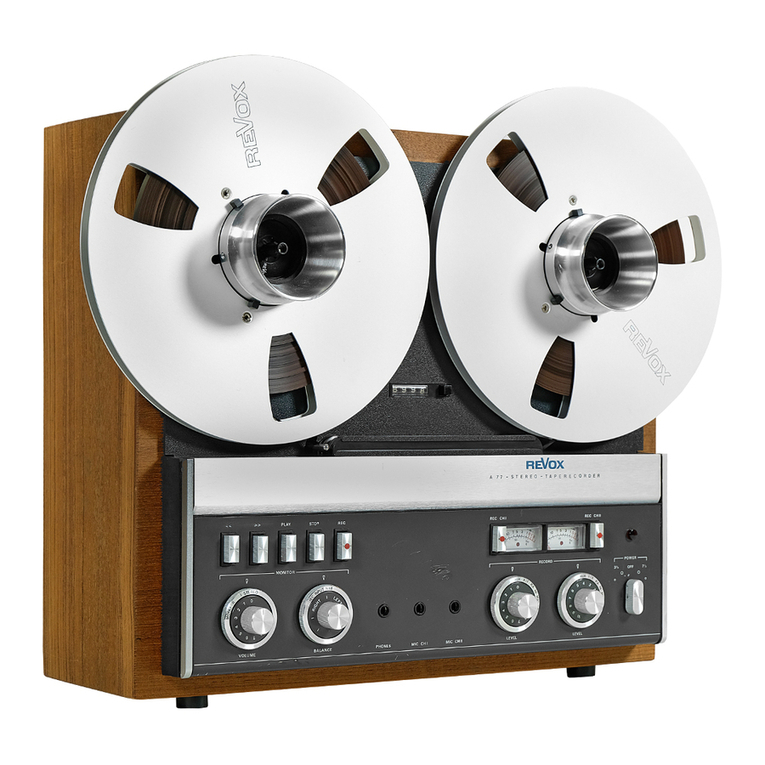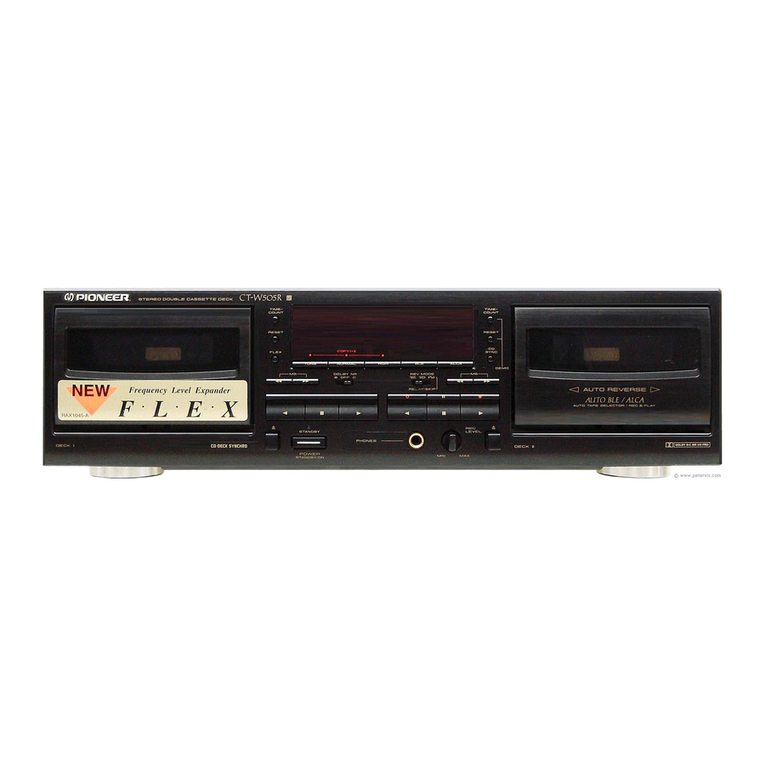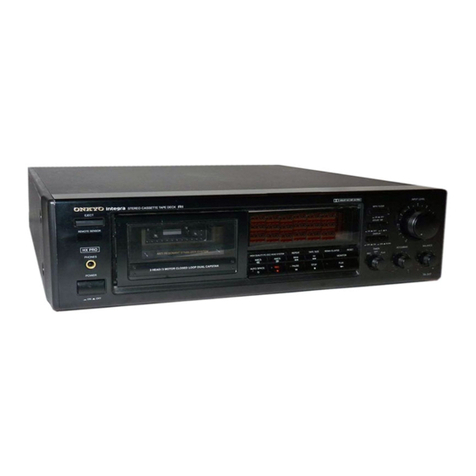Denon DN-780R User manual

STEREO CASETTE TAPE DECK
DN-780R
OPERATING INSTRUCTIONS
BEDIENUNGSANLEITUNG
MODE D’EMPLOI
ISTRUZIONI PER L’USO
FOR ENGLISH READERS PAGE 5 ~ PAGE 13
FÜR DEUTSCHE LESER SEITE 14 ~ SEITE 22
POUR LES LECTEURS FRANCAIS PAGE 23 ~ PAGE 31
PER IL LETTORE ITALIANO PAGINA 32 ~ PAGINA 40
PARA LECTORES DE ESPAÑOL PAGINA 41 ~ PAGINA 49
VOOR NEDERLANDSTALIGE LEZERS PAGINA 50 ~ PAGINA 58
FOR SVENSKA LÄSARE SIDA 59 ~ SIDA 67
INSTRUCCIONES DE OPERACION
GEBRUIKSAANWIJZING
BRUKSANVISNING

2
CAUTION: TO REDUCE THE RISK OF ELECTRIC SHOCK, DO NOT REMOVE COVER
(OR BACK). NO USER SERVICEABLE PARTS INSIDE. REFER SERVICING
TO QUALIFIED SERVICE PERSONNEL.
The lightning flash with arrowhead symbol, within an equilateral triangle, is intended to
alert the user to the presence of uninsulated “dangerous voltage” within the product’s
enclosure that may be of sufficient magnitude to constitute a risk of electric shock to
persons.
The exclamation point within an equilateral triangle is intended to alert the user to the
presence of important operating and maintenance (servicing) instructions in the literature
accompanying the appliance.
WARNING: TO PREVENT FIRE OR SHOCK HAZARD, DO NOT EXPOSE THIS
APPLIANCE TO RAIN OR MOISTURE.
CAUTION
RISK OF ELECTRIC SHOCK
DO NOT OPEN
CAUTION:
1. Handle the power supply cord carefully
Do not damage or deform the power supply cord. If it is
damaged or deformed, it may cause electric shock or
malfunction when used. When removing from wall outlet,
be sure to remove by holding the plug attachment and not
by pulling the cord.
2. Do not open the top cover
In order to prevent electric shock, do not open the top cover.
If problems occur, contact your DENON dealer.
3. Do not place anything inside
Do not place metal objects or spill liquid inside the cassette
tape deck. Electric shock or malfunction may result.
Please, record and retain the Model name and serial number of
your set shown on the rating label.
Model No. DN-780R Serial No.
This device complies with Part 15 of the FCC Rules.
Operation is subject to the following two conditions : (1)
This device may not cause harmful interference, and (2) this
device must accept any interference received, including
interference that may cause undesired operation.
This Class B digital apparatus meets all requirements of the
Canadian Interference-Causing Equipment Regulations.
Cet appareil numérique de la classe B respecte toutes les
exigences du Règlement sur le matériel brouilleur du Canada.
SAFETY INSTRUCTIONS
1. Read Instructions – All the safety and operating instructions
should be read before the product is operated.
2. Retain Instructions – The safety and operating instructions
should be retained for future reference.
3. Heed Warnings – All warnings on the product and in the
operating instructions should be adhered to.
4. Follow Instructions – All operating and use instructions
should be followed.
5. Cleaning – Unplug this product from the wall outlet before
cleaning. Do not use liquid cleaners or aerosol cleaners.
6. Attachments – Do not use attachments not recommended
by the product manufacturer as they may cause hazards.
7. Water and Moisture – Do not use this product near water –
for example, near a bath tub, wash bowl, kitchen sink, or
laundry tub; in a wet basement; or near a swimming pool;
and the like.
8. Accessories – Do not place this product on an unstable cart,
stand, tripod, bracket, or table. The product may fall,
causing serious injury to a child or adult, and serious
damage to the product. Use only with a cart, stand, tripod,
bracket, or table recommended by the manufacturer, or
sold with the product. Any mounting of the product should
follow the manufacturer’s instructions, and should use a
mounting accessory
recommended by the
manufacturer.
9. A product and cart
combination should be
moved with care. Quick
stops, excessive force,
and uneven surfaces may
cause the product and cart
combination to overturn.
10. Ventilation – Slots and openings in the cabinet are provided
for ventilation and to ensure reliable operation of the
product and to protect it from overheating, and these
openings must not be blocked or covered. The openings
should never be blocked by placing the product on a bed,
sofa, rug, or other similar surface. This product should not
be placed in a built-in installation such as a bookcase or rack
unless proper ventilation is provided or the manufacturer’s
instructions have been adhered to.
11. Power Sources – This product should be operated only
from the type of power source indicated on the marking
label. If you are not sure of the type of power supply to
your home, consult your product dealer or local power
company. For products intended to operate from battery
power, or other sources, refer to the operating instructions.
12. Grounding or Polarization – This product may be equipped
with a polarized alternating-current line plug (a plug having
one blade wider than the other). This plug will fit into the
power outlet only one way. This is a safety feature. If you
are unable to insert the plug fully into the outlet, try
reversing the plug. If the plug should still fail to fit, contact
your electrician to replace your obsolete outlet. Do not
defeat the safety purpose of the polarized plug.
13. Power-Cord Protection – Power-supply cords should be
routed so that they are not likely to be walked on or pinched
by items placed upon or against them, paying particular
attention to cords at plugs, convenience receptacles, and
the point where they exit from the product.
15. Outdoor Antenna Grounding – If an outside antenna or
cable system is connected to the product, be sure the
antenna or cable system is grounded so as to provide some
protection against voltage surges and built-up static
charges. Article 810 of the National Electrical Code,
ANSI/NFPA 70, provides information with regard to proper
grounding of the mast and supporting structure, grounding
of the lead-in wire to an antenna discharge unit, size of
grounding conductors, location of antenna-discharge unit,
connection to grounding electrodes, and requirements for
the grounding electrode. See Figure A.
16. Lightning – For added protection for this product during a
lightning storm, or when it is left unattended and unused
for long periods of time, unplug it from the wall outlet and
disconnect the antenna or cable system. This will prevent
damage to the product due to lightning and power-line
surges.
17. Power Lines – An outside antenna system should not be
located in the vicinity of overhead power lines or other
electric light or power circuits, or where it can fall into such
power lines or circuits. When installing an outside antenna
system, extreme care should be taken to keep from
touching such power lines or circuits as contact with them
might be fatal.
18. Overloading – Do not overload wall outlets, extension
cords, or integral convenience receptacles as this can result
in a risk of fire or electric shock.
19. Object and Liquid Entry – Never push objects of any kind
into this product through openings as they may touch
dangerous voltage points or short-out parts that could
result in a fire or electric shock. Never spill liquid of any
kind on the product.
20. Servicing – Do not attempt to service this product yourself
as opening or removing covers may expose you to
dangerous voltage or other hazards. Refer all servicing to
qualified service personnel.
21. Damage Requiring Service – Unplug this product from the
wall outlet and refer servicing to qualified service personnel
under the following conditions:
a) When the power-supply cord or plug is damaged,
b) If liquid has been spilled, or objects have fallen into the
product,
c) If the product has been exposed to rain or water,
d) If the product does not operate normally by following
the operating instructions. Adjust only those controls
that are covered by the operating instructions as an
improper adjustment of other controls may result in
damage and will often require extensive work by a
qualified technician to restore the product to its normal
operation,
e) If the product has been dropped or damaged in any way,
and
f) When the product exhibits a distinct change in
performance – this indicates a need for service.
22. Replacement Parts – When replacement parts are required,
be sure the service technician has used replacement parts
specified by the manufacturer or have the same
characteristics as the original part. Unauthorized
substitutions may result in fire, electric shock, or other
hazards.
23. Safety Check – Upon completion of any service or repairs
to this product, ask the service technician to perform safety
checks to determine that the product is in proper operating
condition.
24. Wall or Ceiling Mounting – The product should be mounted
to a wall or ceiling only as recommended by the
manufacturer.
25. Heat – The product should be situated away from heat
sources such as radiators, heat registers, stoves, or other
products (including amplifiers) that produce heat.
FIGURE A
EXAMPLE OF ANTENNA GROUNDING
AS PER NATIONAL
ELECTRICAL CODE ANTENNA
LEAD IN
WIRE
GROUND
CLAMP
ELECTRIC
SERVICE
EQUIPMENT
ANTENNA
DISCHARGE UNIT
(NEC SECTION 810-20)
GROUNDING CONDUCTORS
(NEC SECTION 810-21)
GROUND CLAMPS
POWER SERVICE GROUNDING
ELECTRODE SYSTEM
(NEC ART 250, PART H)
NEC - NATIONAL ELECTRICAL CODE

3
FRONT PANEL
FRONTPLATTE
PANNEAU AVANT
PANNELLO FRONTALE
PANEL DELANTERO
VOORPANEEL
FRONT PANELEN
REAR PANEL
RÜCKWAND
PANNEAU ARRIERE
IL PANNELLO POSTERIORE
PANEL TRASERO
ACHTERPANEEL
BAKSIDAN
q w e ytr u o
i !0
!1 !22 !3 y t e !5
!6 !6!9 @2@3 !9@1 @0!8 !8!7 !7!4 !4
@4@5@6 @4@5@7 @8@9 #2 #1#0
ENGLISH DEUTSCH FRANCAIS ITALIANO ESPAÑOL NEDERLANDS SVENSKA

4
ENGLISH
•DECLARATION OF CONFORMITY
We declare under our sole responsibility that this
product, to which this declaration relates, is in conformity
with the following standards:
EN60065, EN55013, EN55020, EN61000-3-2 and
EN61000-3-3.
Following the provisions of 73/23/EEC, 89/336/EEC and
93/68/EEC Directive.
•ÜBEREINSTIMMUNGSERKLÄRUNG
Wir erklären unter unserer Verantwortung, daß dieses
Produkt, auf das sich diese Erklärung bezieht, den
folgenden Standards entspricht:
EN60065, EN55013, EN55020, EN61000-3-2 und
EN61000-3-3.
Entspricht den Verordnungen der Direktive 73/23/EEC,
89/336/EEC und 93/68/EEC.
•DECLARATION DE CONFORMITE
Nous déclarons sous notre seule responsabilité que
l’appareil, auquel se réfère cette déclaration, est
conforme aux standards suivants:
EN60065, EN55013, EN55020, EN61000-3-2 et
EN61000-3-3.
D’après les dispositions de la Directive 73/23/EEC,
89/336/EEC et 93/68/EEC.
•DICHIARAZIONE DI CONFORMITÀ
Dichiariamo con piena responsabilità che questo
prodotto, al quale la nostra dichiarazione si riferisce, è
conforme alle seguenti normative:
EN60065, EN55013, EN55020, EN61000-3-2 e EN61000-
3-3.
In conformità con le condizioni delle direttive 73/23/EEC,
89/336/EEC e 93/68/EEC.
QUESTO PRODOTTO E’ CONFORME
AL D.M. 28/08/95 N. 548
•DECLARACIÓN DE CONFORMIDAD
Declaramos bajo nuestra exclusiva responsabilidad que
este producto al que hace referencia esta declaración,
está conforme con los siguientes estándares:
EN60065, EN55013, EN55020, EN61000-3-2 y EN61000-
3-3.
Siguiendo las provisiones de las Directivas 73/23/EEC,
89/336/EEC y 93/68/EEC.
•EENVORMIGHEIDSVERKLARING
Wij verklaren uitsluitend op onze verantwoordelijkheid
dat dit produkt, waarop deze verklaring betrekking heeft,
in overeenstemming is met de volgende normen:
EN60065, EN55013, EN55020, EN61000-3-2 en
EN61000-3-3.
Volgens de bepalingen van de Richtlijnen 73/23/EEC,
89/336/EEC en 93/68/EEC.
•ÖVERENSSTÄMMELSESINTYG
Härmed intygas helt på eget ansvar att denna produkt,
vilken detta intyg avser, uppfyller följande standarder:
EN60065, EN55013, EN55020, EN61000-3-2 och
EN61000-3-3.
Enligt stadgarna i direktiv 73/23/EEC, 89/336/EEC och
93/68/EEC.
NOTE ON USE / HINWEISE ZUM GEBRAUCH /
OBSERVATIONS RELATIVES A L’UTILISATION / NOTE SULL’USO
NOTAS SOBRE EL USO / ALVORENS TE GEBRUIKEN / OBSERVERA
• Avoid high temperatures.
Allow for sufficient heat dispersion when
installed on a rack.
• Vermeiden Sie hohe Temperaturen.
Beachten Sie, daß eine ausreichend
Luftzirkulation gewährleistet wird, wenn das
Gerät auf ein Regal gestellt wird.
• Eviter des températures élevées
Tenir compte d’une dispersion de chaleur
suffisante lors de l’installation sur une
étagère.
• Evitate di esporre l’unità a temperature alte.
Assicuratevi che ci sia un’adeguata
dispersione del calore quando installate
l’unità in un mobile per componenti audio.
• Evite altas temperaturas
Permite la suficiente dispersión del calor
cuando está instalado en la consola.
• Vermijd hoge temperaturen.
Zorg voor een degelijk hitteafvoer indien het
apparaat op een rek wordt geplaatst.
• Undvik höga temperaturer.
Se till att det finns möjlighet till god
värmeavledning vid montering i ett rack.
• Keep the set free from moisture, water, and
dust.
• Halten Sie das Gerät von Feuchtigkeit,
Wasser und Staub fern.
• Protéger l’appareil contre l’humidité, l’eau et
lapoussière.
• Tenete l’unità lontana dall’umidità, dall’acqua
e dalla polvere.
• Mantenga el equipo libre de humedad, agua
y polvo.
• Laat geen vochtigheid, water of stof in het
apparaat binnendringen.
• Utsätt inte apparaten för fukt, vatten och
damm.
• Do not let foreign objects in the set.
• Keine fremden Gegenstände in das Gerät
kommen lassen.
• Ne pas laisser des objets étrangers dans
l’appareil.
• E’ importante che nessun oggetto è inserito
all’interno dell’unità.
• No deje objetos extraños dentro del equipo.
• Laat geen vreemde voorwerpen in dit
apparaat vallen.
• Se till att främmande föremål inte tränger in i
apparaten.
• Handle the power cord carefully.
Hold the plug when unplugging the cord.
• Gehen Sie vorsichtig mit dem Netzkabel um.
Halten Sie das Kabel am Stecker, wenn Sie
den Stecker herausziehen.
• Manipuler le cordon d’alimentation avec
précaution.
Tenir la prise lors du débranchement du
cordon.
• Manneggiate il filo di alimentazione con cura.
Agite per la spina quando scollegate il cavo
dalla presa.
• Maneje el cordón de energía con cuidado.
Sostenga el enchufe cuando desconecte el
cordón de energía.
• Hanteer het netsnoer voorzichtig.
Houd het snoer bij de stekker vast wanneer
deze moet worden aan- of losgekoppeld.
• Hantera nätkabeln varsamt.
Håll i kabeln när den kopplas från el-uttaget.
• Unplug the power cord when not using the
set for long periods of time.
• Wenn das Gerät eine längere Zeit nicht
verwendet werden soll, trennen Sie das
Netzkabel vom Netzstecker.
• Débrancher le cordon d’alimentation lorsque
l’appareil n’est pas utilisé pendant de
longues périodes.
• Disinnestate il filo di alimentazione quando
avete l’intenzione di non usare il filo di
alimentazione per un lungo periodo di tempo.
• Desconecte el cordón de energía cuando no
utilice el equipo por mucho tiempo.
• Neem altijd het netsnoer uit het stopkontakt
wanneer het apparaat gedurende een lange
periode niet wordt gebruikt.
• Koppla ur nätkabeln om apparaten inte
kommer att användas i lång tid.
• Do not let insecticides, benzene, and thinner
come in contact with the set.
• Lassen Sie das Gerät nicht mit Insektiziden,
Benzin oder Verdünnungsmitteln in
Berührung kommen.
• Ne pas mettre en contact des insecticides,
du benzène et un diluant avec l’appareil.
• Assicuratevvi che l’unità non venga in
contatto con insetticidi, benzolo o solventi.
• No permita el contacto de insecticidas,
gasolina y diluyentes con el equipo.
• Laat geen insektenverdelgende middelen,
benzine of verfverdunner met dit apparaat in
kontakt komen.
• Se till att inte insektsmedel på spraybruk,
bensen och thinner kommer i kontakt med
apparatens hölje.
• Never disassemble or modify the set in any
way.
• Versuchen Sie niemals das Gerät
auseinander zu nehmen oder auf jegliche Art
zu verändern.
• Ne jamais démonter ou modifier l’appareil
d’une manière ou d’une autre.
• Non smontate mai, nè modificate l’unità in
nessun modo.
• Nunca desarme o modifique el equipo de
ninguna manera.
• Nooit dit apparaat demonteren of op andere
wijze modifiëren.
• Ta inte isär apparaten och försök inte bygga
om den.
• Do not obstruct the ventilation holes.
• Die Belüftungsöffnungen dürfen nicht
verdeckt werden.
• Ne pas obstruer les trous d’aération.
• Non coprite i fori di ventilazione.
• No obstruya los orificios de ventilación.
• De ventilatieopeningen mogen niet worden
beblokkeerd.
• Täpp inte till ventilationsöppningarna.
* (For sets with ventilation holes)
DEUTSCH FRANCAIS ITALIANO ESPAÑOL NEDERLANDS SVENSKA
CAUTION
• The ventilation should not be impeded by covering the ventilation openings with items, such as newspapers, table-cloths,
curtains, etc.
• No naked flame sources, such as lighted candles, should be placed on the apparatus.
• Please be care the environmental aspects of battery disposal.
• The apparatus shall not be exposed to dripping or splashing for use.
• No objects filled with liquids, such as vases, shall be placed on the apparatus.
• FOR CANADA MODEL ONLY • POUR LES MODELE CANADIENS
UNIQUEMENT
CAUTION ATTENTION
TO PREVENT ELECTRIC SHOCK, MATCH WIDE BLADE
OF PLUG TO WIDE SLOT, FULLY INSERT.
POUR ÉVITER LES CHOCS ÉLECTRIQUES,
INTERODUIRE LA LAME LA PLUS LARGE DE LA FICHE
DANS LA BORNE CORRESPONDANTE DE LA PRISE ET
POUSSER JUSQU’ AU FOND.

qPower Operation Switch (POWER)
Press once to turn the power on, and once more
to turn the power off.
The deck remains in a stand-by (non-operative)
mode for approximately 2 seconds after it is
switched on.
wMaster/Slave Switch
For normal operation, set this to “OFF”.
Set the switch to “MASTER” or “SLAVE” when
using the DN-780R together with other DN-
780Rs.
eDolby NR Switch (DOLBY NR)
Select the Dolby NR type that suits the
recording.
OFF : Recording without Dolby NR
B : Recording with Dolby NR type B
(The “ ” indicator will light up.)
C : Recording with Dolby NR type C
(The “ ” indicator will light up.)
rDubbing Speed Buttons
(DUBBING SPEED)
Pressing the NORMAL button starts regular
speed dubbing from deck A to deck B. Press the
HIGH button to perform dubbing at double
speed. See page 11.
tTape Speed Control (TAPE SPEED)
Use this knob to vary the tape speed. The speed
can be varied within a range of approximately
±12% according to the position of the tape
speed control knob.
yInput Level Control (INPUT LEVEL)
This knob adjusts the recording input level. It
affects the level in both channels. See page 9.
uHeadphone Level Control
Use this to adjust the output level of the
headphones.
iHeadphone Select Switch
(PHONES SELECT)
Use this to select the headphone’s output signal.
A : The Deck A’s signals are output to the
headphones.
MIX : The MIX signals of Deck A and Deck B are
output to the headphones.
B : The Deck B’s signals are output to the
headphones.
5
ENGLISH
Thank you very much for purchasing the DENON
component stereo cassette tape deck.
DENON proudly presents this advanced tape deck to
audiophiles and music lovers as a further proof of
DENON’s non-compromising pursuit of the ultimate in
sound quality. The high quality performance and easy
operation are certain to provide you with many hours
of outstanding listening pleasure.
— TABLE OF CONTENTS —
FEATURES ………………………………………………5
NAMES AND FUNCTIONS OF PARTS …………5 ~ 7
CASSETTE TAPES………………………………………8
AUTOMATIC TAPE SELECTION………………………8
PLAYBACK……………………………………………8, 9
RELAY PLAY ………………………………………8
TWIN OUTPUT ……………………………………8
MUSIC SEARCH SYSTEM ………………………8
POWER ON PLAYBACK …………………………9
RECORDING ………………………………………9, 10
PROPER RECORDING LEVEL ……………………9
REC/REC MUTE AND REC PAUSE BUTTON …9
AUTO-STANDBY …………………………………10
TWIN RECORDING ………………………………10
RELAY RECORDING ……………………………10
SYNCHRONIZED OPERATION …………………10
DUBBING………………………………………………11
MANUAL DUBBING ……………………………11
MEMORY STOP ………………………………………11
PRESET FUNCTION …………………………………11
DOLBY B AND C NOISE REDUCTION SYSTEM …12
DOLBY HX-PRO HEADROOM
EXTENSION SYSTEM ………………………………12
MAINTENANCE ………………………………………12
TROUBLESHOOTING ………………………………13
SPECIFICATIONS ……………………………………13
Please check to make sure the following items are
included with the main unit in the carton:
(1) Operating Instructions…………………………1
(2) Operating Instructions (Applications) ………1
(3) Connection Cords………………………………4
(4) Service Station List ……………………………1
FEATURES
219-inch Rack Mountable
2Independent Input/Output
2Dolby B & C Noise Reduction Systems
(A/B Independent)
2Dolby HX-Pro Headroom Extension System
2Twin Recording and Relay Recording
2Relay Playback
2TS MIC Jacks on Front Panel
2Cascade Recording and Playback
2Synchronized Recording
2RS232C Serial Control Port
2Parallel Remote Control
22-Speed Dubbing
2Quick Auto Reverse
2Speed Control of Approximately ±12%
(A/B Independent)
2Computer Controlled Mechanism
2Computing Tape Counter with 4-Digit Readout and
Memory Stop
2Music Search System
2FL Peak Level Meters
2Auto Tape Selector
2Memory Back-up
2Auto-standby
2XLR Input/Output Kit (Option)
(Model Name :ACD-780)
NAMES AND FUNCTIONS OF PARTS
oHeadphone Jack (PHONES)
For private music enjoyment without disturbing
others, or for monitoring a recording, a
headphone set may be connected to this jack.
Use a headphone with an impedance rating of 8
to 1200 Ω/ohms. Signal are output according to
the position of the PHONES SELECT switch i.
!0 Auto Gain Control Switch of Mic
(MIC AGC)
Selects the microphone level adjustment
method.
OFF : The level is adjusted with the MIC LEVEL
control !3.
ON : The level is adjusted automatically according
to the level of the microphone input signal.
!1 Microphone Jacks (MIC)
Connect the microphone to this jack for
microphone mixed recording.
MIC signals will be mixed with the line input
signals.
Accepts an unbalanced (TS Type) microphone
with 1/4” mono jacks.
When a microphone is only connected to the
L/MONO jack, the recording will be monaural.
Connect to both the L and R jacks for stereo
recording.
NOTE :
To prevent noise, set the MIC MODE switch !2
to “off” when connecting microphones to the
MIC jacks.
!2 Microphone Mode Switch (MIC MODE)
OFF : Turns the microphone input off.
LINE : When in the tape play, record or
recording pause mode, the sound input
to the microphone is output from the
LINE OUT jack. The sound input to the
microphone is not recorded.
REC : Microphone mixed recording is performed.
!3 Microphone Input Level Control
(MIC LEVEL)
Adjust the level of the Microphone inputs.

6
ENGLISH
!5 Input Select Switch of Deck B
(INPUT SELECT)
Select the audio input to the Deck B (DECK A,
LINE A, LINE B).
!6 Cassette Compartment Cover
If the cover is not closed completely, the tape
transport buttons will remain inoperative.
!7 Counter Memory Button
(COUNTER MEMO)
When this button is pressed during forward tape
travel ( 1), fast rewinding ( 6) will stop
automatically at the tape counter position
“‚‚‚‚”.
When this button is pressed during reverse tape
travel ( 0), fast forwarding ( 7) will stop
automatically at the tape counter position
“‚‚‚‚”. See page 11.
!8 Counter Reset Button
(COUNTER RESET)
Press this button to reset the tape counter to
zero.
@9 Cascade Control Jacks (CASCADE)
Connect these for continuous operation on
multiple units.
When the REV. MODE button @0 is set to
“CASCADE”, the start signal is output from this
output jack once operation of Deck B is finished.
#0 Serial Control Port (RS232C)
This is serial remote connector.
Applicable connector : 9-pin D-sub (male)
Baud rate : 9600 bps
Pin layout
!4 Tape Transport Buttons
0 , 1
2
6
7
4
3
Play Button
Stop Button
Fast Rewind Button
Fast Forward Button
Rec/Rec Mute Button
Rec Pause Button
Press to playback tape.
Press to stop the tape in any mode.
Press for fast rewind.
Press for fast forwarding.
Press the Rec/Rec Mute button ( 4) and Play button ( 0, 1)
simultaneously to start recording. If only the Rec/Rec Mute
button ( 4) is pressed, the deck enters the recording pause
mode. Pressing this button in the recording pause mode will
start Auto Rec Mute, and a 5-second silent space is recorded
onto the tape. See page 9.
Press this button to enter the recording pause mode from the
recording or recording mute mode. This button can only be used
during recording. See page 9.
@3 Remote Control Sensor
(REMOTE SENSOR)
This sensor receives the infrared light transmitted
from the wireless remote control unit.
This product dose not come with remote control
unit.
@4 Deck A, B Line Input Jacks (LINE IN)
These are unbalanced inputs using RCA type
jacks.
Use them to input signals to be recorded on a
tape.
@5 Deck A, B Line Output Jacks
(LINE OUT)
These are unbalanced outputs using RCA type
jacks.
@6 Deck A Line Output Select Switch
(DECK A OUTPUT SEL.)
Selects the signal to be output from the Deck A
output jacks.
A : The Deck A signal is output.
A+B : Both the Deck A and Deck B signals are
output.
@7 Deck A Line Input Through Jacks
(THRU)
The signal input to the DECK A LINE IN jacks is
output unchanged.
@8 External Synchronized Control Jacks
(EXT. SYNC.)
Connect these for synchronized recording.
Pin No.
Signal Name
1
6NC
GND
I / O
_
_
2
7NC
TxD O
_
3
8NC
RxD I
_
4
9NC
NC _
_
5 S. GROUND _
!9 Eject Button ( 5)
Press this button to open the cassette
compartment cover. When the tape is running,
press the Stop ( 2) button first to stop tape
transport, then press the Eject ( 5) button.
@0 Reverse Mode Button (REV. MODE)
Select the type of tape transport. The reverse
mode can be set to (one side),
(continuous playback), RELAY (relay playback),
CASCADE (continuous recording/playback on
multiple units is possible).
@1 Twin Recording Button (TWIN REC)
Pressing this button will set both deck A and B
to the recording pause mode. See page 10.
@2 Display
Reverse Mode Indicator
Deck B Peak Level Meter
Deck B Dolby NR
Indicator
Deck A Dolby NR
Indicator
Deck A Peak Level Meter
Deck B Tape CounterDeck A Tape Counter
Twin Rec
Indicator
Lights when deck A is selected with the RC IN control jack.
Deck A
Tape Transport
Indicator
Deck B
Tape Transport
Indicator
Deck A Memory
Indicator
Deck B Memory
Indicator
Lights when deck B is
selected with the RC IN
control jack.
• Synchronized Indicator
• Infrared Remote
Control Indicator
Dubbing Speed Indicator

7
ENGLISH
#1 Parallel Remote Control Port
(PARALLEL)
This is a parallel remote connector.
Applicable connector : 25-pin D-sub (male)
Connecting signal layout
NOTE : All input is active low.
Pin No.
Signal Name
1FG
I / O
_
2TWIN REC I
3A REWIND I
4B FAST FORWARD I
5 DUBBING HIGH I
6B REWIND I
7 A PLAY FORWARD I
8A PLAY REVERSE I
9 A REC I
10 B COUNTER RESET I
11 B PLAY FORWARD I
12 B PLAY REVERSE I
13 A COUNTER MEMO I
1. Circuit Diagram
L _CH
φ3.5 STEREO MINI PLUG
R _CH GND
SW102
SW101
SW001 SW002 SW003 SW004 SW005 SW006 SW007 SW008
STOP PAUSE F _PLAY R _PLAY DECK A/B
FF REW REC/
REC MUTE
GND
R001
200 Ω/ohms R002
30 Ω/ohms R003
43 Ω/ohms R004
62 Ω/ohms R005
110 Ω/ohms R006
160 Ω/ohms R007
270 Ω/ohms R008
560 Ω/ohms
First Unit
Second and Subsequent Units
L-CH : Vcc (5 VOLT)
R-CH : SIGNAL
SW001 ~ 008 : Momentary Contact
SW101, 102 : Toggle Switch
SW 008 DECK A/B
DECK SELECTOR button
Press this button to select either
Deck A or Deck B to be controlled.
• Do not connect the left channel of the plug (Vcc) with R001 (200 Ω/ohms) in the second and subsequent units.
• Use resistors having a tolerance of with ±5%.
Use of resistors having a poorer tolerance will cause incorrect operation.
• Never short circuit the left-channel line (Vcc). Doing so will damage the main unit.
2. Operation with Parallel Connections
A number of DN-780R units can be simultaneously operated in parallel with 1 button.
Operation with parallel connections can be used with a maximum of 5 units.
Connection of 6 or more units will lead to indicator operation.
3. Cable Length
The longer the length of the cable, the more susceptible the system will be to the effects of external noise.
Keep cable lengths to 2 m or less.
Do not locate equipment that produces electrical noise in the vicinity of the cable.
Doing so might lead to incorrect operation due to the noise.
4. Do not disconnect or connect the remote control plug during operation of the unit.
The pins of the plug might cause a short circuit of the pins inside the jack which can stop the operation.
5. Pressing more than one button of the wired remote control box at the same time (for combined operations)
is not possible.
A music search operation will not result from pressing the Play (1) and Fast Forward (7), or Play (0) and
Rewind (6) buttons at the same time.
6. Pressing a button of the wired remote control box and a button of the main unit, DN-780R, (for combined
operations) is not possible.
Note on Connecting the Remote Control Box
When multiple sets are connected to a single remote control box, the other sets may operate erroneously
when this set’s power is turned on off or when the cord is connected or disconnected from the remote control
jack.
Turn off the remote control box’ toggle switched (SW101, 102, ...) when turning this set’s power on or off or
when connecting or disconnecting the cord from the remote control jack while other sets are connected to the
remote control box.
#2 RC IN control Jack
This is a stereo mini jack for wired remote control.
Pin No.
Signal Name
14
I / O
_
15 A COUNTER RESET I
16 B COUNTER MEMO I
17 REVERSE MODE I
18 B REC I
19 A REC PAUSE I
20 A STOP I
21 DUBBING NORMAL I
22 Command common _
23 B REC PAUSE I
24 B STOP I
25 A FAST FORWARD I
3
22
4
22
5
22
7
22
8
22
10
22
9
22
11
22
A 6
2
22
TWIN RECB 7
DUBBING HIGH
6
22
B 6
A 0A 1
13
22
15
22
16
22
18
22
19
22
A MEMO
12
22
B 0A RESET
B MEMO
23
22
24
22
25
22
B 3
21
22
DUBBING NORMALB 2
A 7
17
22
REV. MODE
A 3
20
22
A 2B 4
A 4
B RESET
B 1
1
2
3
4
5
6
7
8
9
10
11
12
13
15
16
18
19
20
21
17
24
25
22
23
Use the connection example in the diagram below as reference for connecting a parallel remote controller
to the DN-780R.

8
ENGLISH
CASSETTE TAPES
2Handling Precautions
• C-120 cassette tapes
C-120 cassette tapes are not recommended as
they use a very thin tape base which may become
tangled around the capstan or pinch roller.
• Tape Slack
Before putting a tape into the deck, take up any
slack with a pencil or your finger tip. This
precaution prevents the tape from becoming
entangled around the capstan or pinch roller.
A
2Storage Precautions
• Do not store cassette tapes in a place where they
will be subject to:
• Extremely high temperature or excessive
moisture
• Excessive dust
• Direct sunlight
• Magnetic fields (near TV sets or speakers)
• To eliminate tape slack, store your cassettes in
cassette cases with hub stops
2Accidental Erasure Prevention
• All cassettes have erasure prevention tabs for each
side. To protect valuable recordings from accidental
or inadvertent erasure, remove the tab for the
appropriate side with a screwdriver or another tool.
• To record on a tape whose erasure prevention tabs
have been removed, cover the tab holes with
adhesive tape.
Erasure prevention tab for
side A
Erasure prevention tab for side B
AUTOMATIC TAPE SELECTION
This Stereo Cassette Deck contains an automatic tape
selector which automatically selects the optimum
bias and equalization for the tape in use.
This is accomplished by detection of the tape type
detections holes in the cassette housing.
• If a tape without tape type detection holes is
used, the deck will be set for normal tapes.
Detection holes
for chrome tape
Detection holes
for metal tape
PLAYBACK
• The operations described below apply to deck A
and deck B alike.
• The numbers in the illustration below depict the
order in which operation steps are carried out.
qPress the POWER switch qto the ON ( ¢)
position.
wPress the Eject ( 5) button !9 to open the cassette
compartment cover !6.
eLoad the cassette tape and close the cassette
compartment cover !6.
rWhen listening to a tape that has been recorded
with Dolby noise reduction, set the DOLBY NR
switch eto match the system used at the time of
recording.
tSelect the type of tape transport with the REV.
MODE button @0.
2RELAY PLAY (continuous playback of the tapes
in deck A and deck B)
• Load a cassette tape into deck A and B, and set the
DOLBY NR switch correctly on deck A and B.
• In the relay play mode, the Deck A and Deck B play
signals are output from the DECK A LINE OUT
jacks.
qREV. MODE button @0 set to “RELAY”.
wPress the Play ( 0or 1) button !4 of the deck
you first wish to listen to. The Play ( 0or 1)
indicator of the deck playing back the tape will
light up.
eTo stop relay play, press the Stop ( 2) button !4
of the deck currently playing the tape.
• The number of cycles for relay playback can be
selected (1, 5 or 10).
For details, refer to “PRESET FUNCTION”
(page 11). When playback starts from deck B,
when switching to deck A, the first deck A
playback cycle will be counted as the second
cycle. The completion of cycles will always be
at the opposite side of the tape in deck B.
• If the playback deck has been switched, be
sure to start playback in the forward direction
(1).
NOTE :
In the relay play mode, it is not possible to perform
the play operations simultaneously on Decks A and
B. If one of the decks is set to the play mode while
the other deck is already in the play mode, playback
is performed on the deck that has just been set to
the play mode and stops on the other deck.
yPress the Play ( 0or 1) button !4 to begin
playback. The Play ( 0or 1) indicator will light
during playback.
uPress the Stop ( 2) button !4 to stop the playback.
• If different types of Dolby noise reduction are
used for record and playback, playback response
will be adversely effected.
• When power is turned off during tape transport,
it may not be possible to remove the cassette
by pressing the Eject ( 5) button !9.
In this case, turn on power again before you
press the Eject ( 5) button !9.
Mode Indicator
To listen to one side only
To listen to repeat playback of
both sides
To listen to continuous playback
of both sides and both decks.
RELAY
or
CASCADE
2TWIN OUTPUT
With the DN-780R, it is possible to play tapes
simultaneously on decks A and B and output their
signals at the same time.
When both decks A and B are played, the signals for
deck A are output from the DECK A LINE OUT jacks,
and the signals from deck B are output from the DECK
B LINE OUT jacks..
• The DECK B LINE OUT jacks are exclusively for the
deck B signals.
• The DECK A LINE OUT jacks are for both the deck
A and deck B signals when deck A line output
select switch set to “A+B”.
• Use the DECK A LINE OUT jacks when connecting
one of the sets of line outputs to a receiver or
amplifier.

9
ENGLISH
2MUSIC SEARCH SYSTEM
The music search system detects blank sections
(lasting for at least 4 seconds) between selections in
order to locate the beginning of selections in the
forward or reverse direction.
1. To advance from the current selection to the
beginning of the next selection (CUE) :
Press the Play ( 1) button simultaneously with
the Fast Forward ( 7) button. Press the Play
( 0) button simultaneously with the Rewind
( 6) button.
The deck will skip the rest of the current selection
and automatically resume play from the beginning
of the next selection.
2. To repeat playback from the beginning of the
current selection (REVIEW) :
Press the Play ( 1) button simultaneously with
the Rewind ( 6) button. Press the Play ( 0)
button simultaneously with the Fast Forward
( 7) button.
The deck will rewind the tape to the beginning of
the current selection and automatically resume
play from that point.
This is very convenient for repeating playback of
the current selection.
Notes on Music Search Operation :
The search functions operates by detecting
comparatively long, blank sections approximately 4 to
5 seconds long, in between recorded selections.
Therefore, the system may not operate normally in
the following cases:
• Recordings with discontinuous speech or
conversation.
• Recordings with long periods of pianissimo (softly
played music).
• Blank sections with a high level of noise.
• Blank sections shorter than 4 seconds.
• If noise-emitting appliances, such as electric razors,
drills, refrigerators, etc., are operated nearby.
• REVIEW close to the beginning of the program or
CUE close to the ending.
2POWER ON PLAYBACK
Playback starts automatically when the power is
turned on.
• Playback is performed according to the reverse
mode set when the power was turned off.
• Playback is performed even if a cassette tape is
only loaded in one deck.
• Playback always starts in the “1” tape travel
direction.
• When tapes are loaded in both Deck A and Deck B,
playback starts from Deck A.
• The power on playback function can be set with
the “PRESET FUNCTION” (page 11).
RECORDING
• The operations described below apply to deck A
and deck B alike.
qPress the POWER switch qto the ON ( ¢)
position.
wLoad the cassette tape !9, !6.
(Check that the erasure prevention tabs of the
cassette housing have not been broken off.)
eSelect the Dolby NR type that suits the recording.
rSelect the type of tape transport with the REV.
MODE button @0.
tPress the Rec/Rec Mute ( 4) button !4 to set the
recording pause mode. The 4 3 indicator will light
up.
yAdjust the recording level with the INPUT LEVEL
control ywhile watching the Peak Level Meter.
uRecording starts when the Play ( 0or 1) button
!4 for the direction indicated by the flashing tape
travel indicator ( 0or 1) is pressed. If the other
Play ( 0or 1) button !4 is pressed, the direction
of tape travel changes.
The Play ( 0or 1) and the 4indicator will light
during recording.
iTo stop recording, press the Stop ( 2) button !4.
oTo pause the recording, press the Rec Pause ( 3)
button !4. Press the Play ( 0or 1) button !4 to
resume recording.
NOTE :
For Deck B, the input source can be selected.
Select the desired line input beforehand using the
INPUT SELECT switch.
DECK A : The sound playing on Deck A can be
recorded. (Refer to “MANUAL DUBBING”
(page 11)).
LINE A : The sound input to the DECK A LINE IN
jacks can be recorded.
LINE B : The sound input to the DECK B LINE IN
jacks can be recorded.
Mode Indicator
To record on only one side
To continuously record on both
sides
,
RELAY
or
CASCADE
Caution :
Be careful not to erase important recordings by
mistake. Inadvertent start of recording will happen
in the following cases:
1. If the Play ( 0or 1) button is pressed while the
4indicator lights, recording starts.
2. If the Play ( 0or 1) button and Rec/Rec Mute
( 4) button are pressed at the same time,
recording starts.
The best way to avoid accidental erasure is to break
off the two erasure prevention tabs on the cassette
housing.
2PROPER RECORDING LEVEL
A too high recording level can saturate the tape and
cause distortion. On the other hand, if the recording
level is set too low, soft passages will be marked by
residual noise. A proper recording level is the most
important factor for making well balanced recordings.
Guideline for maximum recording level
Type I(Normal) +3 dB level on peaks
Type II (CrO2)
Type IV (Metal) +3 dB level on peaks
+3 dB level on peaks
Note :
The optimum recording level differs depending on
the program source and the type of tape used.
2REC/REC MUTE AND REC PAUSE BUTTONS
1. To record a 5-second blank section during
recording:
Press the Rec/Rec Mute ( 4) button. A 5-second
blank will be recorded and the deck will enter the
recording standby mode.
2. To record a 5-second blank section during the
recording standby mode:
Press the Rec/Rec Mute ( 4) button from the
recording standby mode. A 5 second blank will be
recorded and the deck will enter the recording
standby mode again.
3. To cancel recording of blank space:
Press the Rec Pause ( 3) button. Blank space
recording will be cancelled and the deck enters
the recording standby mode.
4. To extend the blank section with another 5
seconds or more:
Simply press the Rec/Rec Mute ( 4) button and
the blank section will be increased with another 5
seconds.

10
ENGLISH
2AUTO-STANDBY
This function is extremely convenient when conducting
relay recording, relay playback, twin recording or tape
copying.
• When the Fast Rewind ( 6) and Rec Pause ( 3)
buttons are pressed simultaneously while in the
stop mode and the tape is set to play in the forward
direction ( 1), the tape is rewound to the
beginning, then played to the end of the leader
tape and stopped automatically at the beginning of
the magnetic tape.
• When the Fast Forward ( 7) and Rec Pause ( 3)
buttons are pressed simultaneously while in the
stop mode and the tape is set to play in the reverse
direction ( 0), the tape is fast-forwarded to the
end, then played in the reverse direction to the end
of the leader tape and stopped automatically at the
beginning of the magnetic tape.
• The Play ( 0or 1) indicator flashes during the
auto-standby mode.
Caution :
If recording is started after using the auto standby
function with a recorded tape, the sound of the
previous recording may not be completely erased.
In such cases, rewind the tape before starting to
record.
2TWIN RECORDING (simultaneous recording on
deck A and deck B)
This is a convenient feature for recording the same
program source onto two tapes at the same time.
• This function records the source input to the DECK
A LINE IN jacks.
• Input the source you want to record to the DECK A
LINE IN jacks.
• Load cassette tapes into both deck A and B. Set
the DOLBY NR switch (Deck A only) and REV.
MODE button.
• In the twin recording mode, only the recording
monitor signal of the DECK A LINE OUT jacks is
output.
qPress the TWIN REC button @1. The
indicator will light up and both decks will enter the
recording pause mode.
wAdjust the INPUT LEVEL-A control yfor the best
recording input levels while watching the Peak
Level Meter.
ePress the Play ( 0or 1) button !4 (deck A or B)
to start twin recording.
rTo stop twin recording, press the Stop ( 2) button
!4 of each deck.
• By pressing the both deck A and B Rec Pause ( 3)
button !4, the recording pause or recording mute
mode on both decks can be set automatically.
• To set the twin recording mute mode from the twin
recording pause mode, press the Rec/Rec Mute
(4) button on both deck A and B for at least 0.5
seconds.
• The relay or cascade mode cannot be set with the
REV. MODE button when in the twin recording
mode.
2RELAY RECORDING (continues recording from
deck A to deck B)
To record a long program, start recording on deck A,
and when both sides of the tape in deck A have been
recorded, the relay recording feature continues to
record on the tape in deck B.
• This function records the source input to the DECK
A LINE IN jacks.
• Load cassette tapes into decks A and B, and set
the DOLBY NR switch both deck A/B.
qREV. MODE button @0 set to “RELAY”.
The RELAY indicator will light.
Recording Order
Deck A
Side facing you
/ Opposite side
Side facing you
/ Opposite side
Deck B
wAdjust the INPUT LEVEL control yof both deck A
and B for the best recording input level while
watching the Peak Level Meter.
ePress the Rec/Rec Mute ( 4) button !4 of deck A
to set the recording pause mode.
rPress the Play ( 0or 1) button !4 of deck A to
start relay recording.
tTo stop relay recording, press the Stop ( 2) button
!4 of the deck that is recording.
If recording has been switched from Deck A to
Deck B, be sure to start recording in the forward
direction (1).
NOTE :
In the relay recording mode, it is not possible to
perform the recording operations simultaneously on
Decks A and B. Nothing happens if the recording
operation is performed on one of the decks while
the other deck is already in the recording mode.
2SYNCHRONIZED OPERATION
• The synchro function can be used when the DN-
780R is used together with a Denon product
equipped with an EXT. SYNC. IN/OUT jack.
• Twin recording in sync with another DN-780R is
possible.
• Use a single RCA cable to connect the units’ EXT.
SYNC. OUT jacks with the units’ EXT. SYNC. IN
jacks.
qPress the TWIN REC button @1 on one of the
units.
The twin recording command is output from the
EXT. SYNC. OUT jack and the other unit is set to
the twin recording mode.
wPress the Play ( 0or 1) button !4 on one of the
units.
The play command is output from the EXT. SYNC.
OUT jack and twin recording also starts on the
other unit.
ePress the Stop ( 2) button !4 on one of the units.
The stop command is output from the EXT. SYNC.
OUT jack and the other unit is also set to the stop
mode.

11
ENGLISH
DUBBING (from deck A to deck B)
qPress the POWER switch qto the ON ( ¢)
position.
wLoad the cassette tape to be played in deck A and
the one to be recorded in deck !9, !6.
eSelect the type of tape transport with the REV.
MODE button @0.
Operation
Reverse
mode
Dubbing is performed only for one
side.The decks stop when either
deck A or B reaches the end of the
tape.
During dubbing of the side facing
you, the deck that first reaches the
end of the tape will stand by until the
other deck reaches the end of the
tape, then both decks will reverse
the tape direction together.
(Depending on the manufacturer, the
length of tapes having the same
recording time may differ somewhat.
Setting this mode permits the
arrangement of the beginning portion
of the opposite side of the tape.)
RELAY
or
CASCADE
The tape direction is reversed on
each deck when they reach the end
of the tape. (This is convenient for
dubbing to a tape with a different
length.)
rTo begin normal speed dubbing, press the
DUBBING SPEED NORMAL button r. The DUB
indicator will light at this time.
To high speed dubbing, press the DUBBING
SPEED HIGH button r.
The HIGH indicator will light at this time.
tTo stop dubbing, press the Stop ( 2) button !4 of
deck A or deck B.
• When dubbing, the recording level and the Dolby
NR coding will be the same as those of the
playback tape, regardless of the positions of the
INPUT LEVEL control and the DOLBY NR switch.
• When listening to the playback sound during
normal speed dubbing, set the DOLBY NR switch
to match the Dolby NR system with which the
playback tape was recorded. This will assure
correct sound reproduction, but does not affect the
recording.
• The playback sound cannot be heard during high
speed dubbing.
• Operation using the Rec/Rec Mute ( 4) and Rec
Pause ( 3) buttons of deck B is permitted during
normal speed dubbing.
• Buttons other than the Stop ( 2) button cannot be
used during high speed dubbing.
• In the normal speed dubbing mode, play signals are
only output from the DECK A LINE OUT jacks. In
the high speed dubbing mode, no sound is output.
2MANUAL DUBBING
• With this function, the signal played on Deck A can
be recorded manually on the tape in Deck B.
• The manual dubbing function is also used to record
the signal of the Deck A tape with which the
microphone input signal has been mixed onto the
tape in Deck B.
qPerform steps eto tin the “PLAYBACK”
section on Deck A.
wPerform steps wto tin the “RECORDING”
section on Deck B. Set to Deck B INPUT SELECT
switch to Deck A.
eSet deck A to the play mode and adjust the
recording level using the INPUT LEVEL-B control
y.
rConnect microphones to the MIC jacks !1 and set
the MIC MODE switch !2 to the “REC” mode.
tSet the microphone input level with the MIC
INPUT LEVEL control !3. Also set the MIC AGC
switch !0 to “ON”.
yStart playback on Deck A and recording on Deck
B.
NOTE :
This operation is not possible if the reverse mode is
set to RELAY or CASCADE.
To prevent noise, set the MIC MODE switch to
“off” when connecting microphones to the MIC
jacks.
MEMORY STOP
1. MEMORY STOP Operation
(1) During recording or playback, the Memory
Stop feature can be used to locate a particular
point on the tape. Press the COUNTER
MEMO button at the desired point.
(2) The MEMO indicator lights.
(3) When the Rewind ( 6) button is pressed
during forward tape travel ( 1), or the Fast
Forward ( 7) button is pressed during
reverse tape travel ( 0), the tape is rapidly
rewound (or advanced) until the counter
indication of “‚‚‚‚” is reached.
• The Memory Stop feature will rewind or forward
the tape to within _5 counts in the forward ( 1)
direction (from “‚‚‚‚” to “_‚‚‚fi”) and to within
+5 counts in the reverse ( 0) direction (from
“‚‚‚‚” to “‚‚‚fi”).
• The Memory Stop function operation independently
in both directions for deck A and deck B.
Caution :
If the memory stop operation is performed after
repeated fast-forwarding or rewinding, the tape may
not stop at the proper position.
2. Display Back-up
The COUNTER VALUE, MEMO, DIRECTION and
REV. MODE functions are protected for
approximately one month by a memory back-up.
Once the back-up period is up, the MEMO
settings are set to off, the DIRECTION setting is
set to 1, and the counter is reset to “‚‚‚‚”.
PRESET FUNCTION
• Use these functions to preset the DN-780R’s
operation modes. These presets are stored in
permanent memory, so they are not cleared even
when the power is turned off.
• The preset procedure can be performed in the stop
mode of both the deck A and deck B.
qPress the Stop ( 2) button !4 on Deck A and the
Stop ( 2) button !4 and REV. MODE button @0 on
Deck B simultaneously.
wPress the Play ( 1) button !4 on Deck A and
select the preset item.
Preset items :
1) Setting of number of cycles for “ ” or
“RELAY MODE”
2) Setting of power on play mode (on or off)
3) Setting of infrared remote control codes to be
received
4) Infrared remote control sensor setting (on or
off)
ePress the Play ( 1) button !4 on Deck B to
change the settings.
1) Number of cycles for the relay mode
“Loop 01” : Stop relay play after 1 cycle.
*“Loop 05” : Stop relay play after 5 cycles.
“Loop 10” : Stop relay play after 10 cycles.
2) Power on play setting (on/off)
“P-on P on” : Power on play on
*“P-on P oFF” : Power on play off
3) Infrared remote control codes to be received
*“rc dnon”: Receive Denon codes.
“rc rc-5”: RC-5 codes can be received.
4) Infrared remote control sensor setting (on/off)
*“ir on”: Accept infrared remote control
signals.
“ir oFF”: Do not accept infrared remote
control signals.
“*” indicates the default setting.
rThe preset mode is canceled when the Stop ( 2)
button !4 on Deck A or Deck B is pressed. The
settings are written at this time.

12
ENGLISH
DOLBY B AND C NOISE REDUCTION SYSTEM
2The Dolby noise reduction system substantially
reduces the tape background noise (hiss) inherent
in the cassette medium. Dolby B NR is most
widely in use. However Dolby C NR is a much
more recent development and represents
significant improvements over Dolby B NR.
2Tape background noise consists primarily of high
frequency information, which is particularly
annoying during soft passages. The Dolby NR
system increases the level of low volume mid-
and high-frequency signals during recording and
reduces the level of these signals by an identical
amount during playback. As a result, the playback
signal is identical to the original source, but the
level of background noise generated by the tape is
greatly reduced.
2The operating principle of Dolby C NR is similar to
that of Dolby B NR except for the encoding
/decoding response curves. The noise reduction
effect obtained with Dolby C NR is up to 20 dB,
compared to 10 dB with Dolby B NR. In addition,
Dolby C NR uses an anti-saturation network and
spectral skewing circuitry for a significant
improvement in the dynamic range of the mid- to
high-frequencies.
DOLBY HX-PRO HEADROOM EXTENSION SYSTEM
This deck is equipped with the Dolby HX-PRO
headroom extension system. Since the system
functions automatically during recording, no switching
operation or adjustment is required. The system is
effective with any type of Normal, CrO2and Metal
tape.
The Dolby HX-PRO headroom extension system
functions during recording to raise the saturation level
in the treble range. Therefore, most of the treble
range components distorted or lost during recording
on conventional cassette decks are more faithfully
recorded on the new DENON cassette deck.
Features of the Dolby HX-PRO Headroom
Extension System
(1) Performance of Normal and CrO2tapes can be
improved to very close of that offered by Metal
tape.
(2) The dynamics in the treble range are improved
significantly.
(3) Since no decoding is necessary during playback,
the improved sound can be enjoyed on any type of
tape deck, including portable players and car audio
systems.
(4) The system functions whether the Dolby B/C NR
system is engaged or not.
MAINTENANCE
2Head cleaning
After long usage, tape coating or dust may adhere
to the heads, causing deterioration of sound.
Therefore, the parts depicted in the illustration
should be cleaned regularly. Use a cotton swab
moistened with a tape head cleaning solution
(such as alcohol).
NOTES :
1. Some cleaning cassettes on the market have a
strong abrasive effects and may scratch the
heads. Always use cotton swabs instead of
cleaning cassettes.
2. Since the use of metal tape is apt to collect
more dust on the heads, the heads should be
cleaned more often to enjoy the best possible
sound.
2Cleaning the Pinch Rollers and Capstans
If the pinch rollers or capstans accumulate dust,
tape transport may become unstable, as a result
from slippage, during recording or playback. The
tape can also be damaged if it gets entangled in
the capstan.
Clean these parts with a cotton swab or a soft
cloth moistened with a tape head cleaning solution
(such as alcohol).
2Demagnetizing the Heads
The heads will become magnetized after long
usage or if strongly magnetized objects are
brought near them. The result is a generation of
noise, loss of the high frequency range, and in
extreme cases erasure of treble components on
pre-recorded tapes in combination with added
noise.
Thus, the heads should be demagnetized at regular
intervals. (Head demagnetizers are separately
available from your dealer.)
2How to Demagnetize the Tape Heads
1. Turn off the power.
2. Turn on the demagnetizer while it is at least 30
cm away from the heads. Bring the demagnetizer
near the heads and slowly move it in small
circles four or five times in front of each head,
making sure you do not touch them.
3. Slowly move the demagnetizer away and turn
it off when it is at least 30 cm away from the
heads.

13
ENGLISH
TROUBLESHOOTING
Check the following before you draw the conclusion that your Stereo Cassette Deck is malfunctioning.
1. Are all the connections correct?
2. Are all system components being operated correctly in accordance with the operating instructions?
3. Are the speakers and amplifier/receiver functioning correctly?
If the tape deck still does not function properly, check the symptom against the list below. If the symptom does
not correspond to the check list, please contact your DENON dealer.
Problem Cause Remedy
Tape does not run. • Power cord is disconnected.
• Tape is loose.
• Cassette is not loaded properly.
• Defective cassette.
• Check power cord.
• Tighten tape with a pencil, etc.
• Load cassette properly.
• Replace cassette.
Tape is not recorded when Rec/Rec
Mute (4) button is pressed.
• No cassette is loaded.
• Erase prevention tabs are broken
off.
• Load cassette.
• Cover holes with adhesive tape.
Sound is warbled or distorted. • Heads, capstan or pinch roller are
dirty.
• Tape is wound too tight.
• Recording input level is too high.
• Tape is worn out and has “drop-
outs”.
• Clean them.
• Fast forward or rewind to loosen
tape winding.
• Adjust recording input level.
• Replace tape.
Excessive noise. • Tape is worn.
• Heads, capstan or pinch roller are
dirty.
• Heads are magnetized.
• Recording input level is too low.
• Replace tape.
• Clean them.
• Demagnetize heads.
• Adjust recording input level.
High frequency range (treble) is
emphasized.
• DOLBY NR switch is set
improperly.
• Set DOLBY NR switch properly.
The cassette tape cannot be
removed.
• If the POWER switch is turned
off either during recording or
playback and the unit is stopped,
there may be cases when the
cassette cannot be removed,
even if the Eject ( 5) button is
pressed.
• Turn the POWER switch ON ( ¢)
again, and then press the Stop
( 2) button.
• Now, press the Eject ( 5) button
to remove the cassette tape.
SPECIFICATIONS
Type Vertical tape loading; 4-track 2-channel
stereo double cassette deck
Heads Recording/playback head (hard parmalloy) x 2
Erase head (Double-gap ferrite) x 2
Motors Capstan (DC servo motor) x 2
Real (DC motor) x 2
Tape Speed 4.8 cm/sec.
Variable (PLAY) Approx. ±12%
Fast Forward,
Rewind Time Approx. 110 sec. with a C-60 cassette
Recording Bias Approx. 105 kHz
Overall S/N Ratio
(at 3% THD level) Dolby C NR on: more than 74 dB (CCIR/ARM)
Overall Frequency
Response 20 ~ 18,000 Hz ±3 dB (at –20 dB, Metal tape)
Channel Separation More than 40 dB (at 1 kHz)
Wow & Flutter 0.06% WRMS, ±0.14% w. peak
Input Sensitive
LINE 50 mV (input level maximum)
Input impedance : 240 kΩ/kohms unbalanced
MIC 0.775mV (mic level maximum)
Output Level
LINE 775 mV (0 dB)
(with 47 kΩ/kohms load, recorded level of 200 pwb/mm)
PHONES 7 mW output level at maximum (33 Ω/ohms)
Power Supply U.S.A.,Canada and Taiwan R.O.C. models : 120 V AC±10%, 60Hz
Europian models : 230 V AC±10%, 50Hz
Power Consumption 33W
Dimensions 483 (W) x 134 (H) x 275 (D) mm
Mass 6.5 kg (14 lbs 5 oz)
Installation 19-inch rack mountable (3U)
For improvement purposes, specifications and design are subject to change without notice.
Dolby noise reduction and HX Pro headroom extension manufactured under license from Dolby Laboratories
Licensing Corporation. HX Pro originated by Bang & Olufsen.
“DOLBY”, the double-D symbol and “HX PRO” are trademarks of Dolby Laboratories Licensing Corporation.
High frequency range (treble) is
lost.
• Heads are dirty.
• Tape is worn.
• Clean them.
• Replace tape.

qNetzbetriebschalter (POWER)
Drücken Sie einmal, um die Stromversorgung
einzuschalten, und noch einmal, um die
Stromversorgung wieder auszuschalten.
Das Cassettendeck bleibt für ca. 2 Sekunden,
nach dem es eingeschaltet wurde, in
Bereitschaftsposition.
wMaster/Slave-Schalter
Stellen Sie diesen Schalter für den normalen
Betrieb auf “OFF”.
Stellen Sie den Schalter auf “MASTER” oder
“SLAVE”, wenn Sie das DN-780R zusammen
mit anderen DN-780Rs benutzen.
eDolby NR-Schalter (DOLBY NR)
Wählen Sie den zu der Aufnahme passenden
Dolby NR-Typ.
OFF : Aufnahme ohne das Dolby-
Rauschunterdrückungssystem (DOLBY
NR)
B : Aufnahme mit Dolby-
Rauschunterdrückungssystem B
(Dolby NR) (Die “ ” -Anzeige leuchtet
auf.)
C : Aufnahme mit Dolby-
Rauschunterdrückungssystem C
(Dolby NR) (Die “ ” -Anzeige leuchtet
auf.)
rGeschwindigkeitstasten für das
Überspielen (DUBBING SPEED)
Wenn Sie die NORMAL-Taste drücken, beginnt
das Überspielen mit normaler Geschwindigkeit
von Cassettendeck A auf Cassettendeck B.
Wenn Sie die HIGH-Taste drücken, wird bei
doppelter Geschwindigkeit überspielt. Sehen
Sie Seite 20.
tBandgeschwindigkeits-Regler
(TAPE SPEED)
Mit diesem Regler können Sie die
Bandgeschwindigkeit variieren.
Die Geschwindigkeit kann in einem Bereich von
ca. ±12% entsprechend der Einstellung des
Bandgeschwindigkeits-Reglers justiert werden.
yEingangspegel-Regler (INPUT LEVEL)
Stellen Sie mit diesem Regler den
Eingangspegel ein. Der Pegel beider Kanäle wird
gleichermaßen von der Einstellung beeinflußt.
Sehen Sie Seite 18.
uKopfhörer-Pegelregler
Stellen Sie hiermit den Ausgangspegel der
Kopfhörer ein.
14
DEUTSCH
Wir danken Ihnen für den Kauf des DENON Stereo-
Cassettendecks.
Voller Stolz präsentiert DENON allen Audiofans und
Musikliebhabern dieses fortschrittliche Cassettendeck,
das ein weiterer Beweis für das kompromißlose
Streben von DENON nach vollkommener Klangqualität
ist. Aufgrund der hochqualitativen Leistungsfähigkeit
und der leichten Bedienung dieses Gerätes werden Sie
beim Zuhören viele Stunden lang Ihre Freude haben.
— INHALT —
MERKMALE……………………………………………14
BEZEICHNUNGEN DER TEILEN UND
IHRE FUNKTIONEN ……………………………14 ~ 16
CASSETTENBÄNDER ………………………………17
AUTOMATISCHER BANDSORTENWÄHLER ……17
WIEDERGABE ……………………………………17, 18
FOLGE-WIEDERGABE……………………………17
ZWILLINGS-AUSGANG …………………………17
TITELSUCHLAUF-SYSTEM………………………18
WIEDERGABESTART BEIM EINSCHALTEN
DES GERÄTES ……………………………………18
AUFNAHME ………………………………………18, 19
RICHTIGER AUFNAHMEPEGEL
…………………18
AUFNAHME/AUFNAHMESTUMMSCHALTTASTE
UND AUFNAHME PAUSENTASTE ……………18
AUTO-STANDBY …………………………………19
DOPPEL-AUFNAHME …………………………19
FOLGE-AUFNAHME ……………………………19
SYNCHRONBETRIEB ……………………………19
ÜBERSPIELEN…………………………………………20
MANUELLES ÜBERSPIELEN……………………20
SPEICHERSTOPP ……………………………………20
SPEICHERFUNKTIONEN ……………………………20
DOLBY B UND C
RAUSCHUNTERDRÜCKUNGSSYSTEM……………21
DOLBY HX-PRO SYSTEM ZUR ERWEITERUNG
DES AUSSTEUERUNGSMARGINALS………………21
WARTUNG ……………………………………………21
FEHLERSUCHE ………………………………………22
TECHNISCHE DATEN ………………………………22
Überprüfen Sie, daß die nachstehend aufgeführten
Teile im Karton des Hauptgerätes enthalten sind:
(1) Bedienungsanleitung …………………………1
(2) Bedienungsanleitung (Anwendungen) ………1
(3) Anschlußkabel
……………………………………4
(4) Kundendienstverzeichnis ……………………1
MERKMALE
219-Zoll Rackmontage
2Unabhängiger Eingang/Ausgang
2Dolby B und C Rauschunterdrückungssystem
(A/B unabhängig voneinander)
2Dolby HX-Pro Aussteuerungssystem
2Doppel-Aufnahme und Folge-Aufnahme
2Folge Wiedergabe
2TS MIC-Buchsen am vorderen Bedienfeld
2Kaskaden-Aufnahme und -Wiedergabe
2Synchronisierte Aufnahme
2Serielle Schnittstelle RS232C
2Parallele Fernbedienung
2Überspielen mit 2 Geschwindigkeiten
2Schneller Auto-Rücklauf
2Verstellung der Bandgeschwindigkeit mit
ungefähr ±12% (A/B unabhängig)
2Computergesteuerter Mechanismus
2Computergesteuertes Bandzählwerk mit 4-
stelliger Ziffernanzeige und Speicherstopp
2Titelsuchlauf
2FL Spitzenpegelmesser
2Automatischer Bandsortenwähler
2Speicher-Reserve
2Auto-Standby
2XLR-Eingangs-/-Ausgangssatz-Option
(Modellbezeichnung: ACD-780)
BEZEICHNUNGEN DER TEILEN UND IHRE FUNKTIONEN
i
Kopfhörer-Wahlschalter (PHONES SELECT)
Wählen Sie hiermit das Kopfhörer-
Ausgangssignal aus.
A : Die Signale von Deck A werden an den
Kopfhörern ausgegeben.
MIX : Die MIX-Signale von Deck A und Deck B
werden zu den Kopfhörern ausgegeben.
B : Die Signale von Deck B werden an den
Kopfhörern ausgegeben.
oKopfhörerbuchse (PHONES)
Für das Genießen von Musik, ohne dabei andere
zu stören oder für das Mitanhören einer Aufnahme,
kann an diese Buchse ein Paar Kopfhörer
angeschlossen werden. Verwenden Sie Kopfhörer
mit einer Nennimpedanz von 8 bis 1200 Ω/Ohm.
Die Signale werden entsprechend der Position des
PHONES SELECT-Schalters
i
ausgegeben
.
!0 Schalter für die automatische
Verstärkungssteuerung des Mikrofons
(MIC AGC)
Zur Auswahl des Mikrofonpegel-
Einstellungsverfahrens.
OFF : Der Pegel wird mit dem MIC LEVEL-
Regler !3 eingestellt.
ON : Der
Pegel wird automatisch entsprechend
des Pegels des Mikrofon-Eingangssignals
eingestellt.
!1 Mikrofonbuchsen (MIC)
Schließen Sie das Mikrofon für die Mikrofon-
Mischaufnahme an diese Buchse an.
MIC-Signale werden mit den Line-
Eingangssignalen gemischt.
Akzeptiert ein asymmetrisches Mikrophon (TS-
Typ) mit einem 1/4”-Mono-Anschluss.
Wenn nur an die L/MONO-Buchse ein Mikrofon
angeschlossen ist, wird die Aufnahme in
Einkanalton ausgeführt.
Schließen Sie für die Stereo-Aufnahme sowohl
an die L- als auch R-Buchsen an.
HINWEIS:
Zur Vermeidung von Störungen sollten Sie den
MIC MODE-Schalter
!
2auf “off” (aus) stellen,
wenn Sie Mikrofone an die MIC-Buchsen
anschließen.
!2 Mikrofon-Modus-Schalter (MIC MODE)
OFF : Schaltet den Mikrofon-Eingang aus.
LINE : Wenn der Bandwiedergabe-, Aufnahme-
oder Aufnahmepause-Modus aktiviert ist,
wird der zum Mikrofon eingegebene Ton
von der LINE OUT-Buchse ausgegeben.
Der in das Mikrofon eingegebene Ton
wird nicht aufgenommen.
REC : Die Mikrofon-Mischaufnahme wird
ausgeführt.
!3
Mikrofon-Eingangspegelregler (MIC LEVEL)
Stellen Sie den Pegel der Mikrofon-Eingänge ein.

15
DEUTSCH
!5 Eingangswahlschalter von Deck B
(INPUT SELECT)
Wählen Sie den Audio-Eingang für Deck B
(DECK A, LINE A, LINE B).
!6 Cassettenfachdeckel
Wenn der Cassettenfachdeckel nicht vollständig
geschlossen ist, sind die Bandlauftasten nicht
bedienbar.
!7 Bandzählwerk-Speichertaste
(COUNTER MEMO)
Wenn diese Taste während des Bandlaufes in
Vorlaufrichtung ( 1) gedrückt wird, stoppt der
Schnell-Rücklauf ( 6) automatisch, wenn das
Bandzählwerk die Position “‚‚‚‚” erreicht hat.
Wenn diese Taste während des Bandlaufes in
Rücklaufrichtung ( 0) gedrückt wird, stoppt der
Schnell-Vorlauf ( 7) automatisch, wenn das
Bandzählwerk die Position “‚‚‚‚” erreicht hat.
Sehen Sie Seite 20.
!8 Bandzählwerk-Rückstelltaste
(COUNTER RESET)
Drücken Sie diese Taste, um das Bandzählwerk
auf null zurückzustellen.
@9 Kaskaden-Steuerbuchsen (CASCADE)
Schließen Sie diese Buchsen für den
kontinuierlichen Betrieb auf mehreren Geräten an.
Wenn die REV. MODE-Taste @0 auf “CASCADE”
eingestellt ist, wird das Startsignal an dieser
Ausgangsbuchse ausgegeben, wenn der
Betrieb von Deck B beendet ist.
#0 Serielle Schnittstelle (RS232C)
Hierbei hande lt es sich um den seriellen
Fernanschluss.
Verwendbarer Stecker: 9-poliger D-Sub (Stecker)
Baudrate : 9600 bps
Pinanordnung
!4 Bandlauftasten
0 , 1
2
6
7
4
3
Wiedergabetaste
Stopptaste
Rücklauftaste
Schnellvorlauftaste
Aufnahme-/
Aufnahme-
Stummschalttaste
Aufnahme-Pausentaste
Für die Wiedergabe drücken.
Zum Stoppen des Cassettenbandes in jeder Betriebsart drücken.
Für den Schnell-Rücklauf drücken.
Für den Schnellvorlauf drücken.
Drücken Sie für den Aufnahmebeginn die Aufnahme-/Aufnahme-
Stummschalttaste (4) und die Wiedergabetaste ( 0, 1)
gleichzeitig. Wenn Sie nur die Aufnahme-/Aufnahme-
Stummschalttaste (4) drücken, setzt sich das Gerät in die
Aufnahme-Pausenbetriebsart. Wenn Sie diese Taste aus der
Aufnahme-Pausenbetriebsart heraus drücken, beginnt die
automatische Aufnahme-Stummschaltung, und eine Leerstelle
von 5 Sekunden wird auf das Cassettenband mit aufgenommen.
Sehen Sie Seite 18.
Drücken Sie diese Taste, um die Aufnahme-Pausenbetriebsart
von der Aufnahme- oder Aufnahme-/Stummschaltbetriesart zu
erreichen. Diese Taste kann nur während der Aufnahme betätigt
werden. Sehen Sie Seite 18.
@3 Fernbedienungssensor
(REMOTE SENSOR)
Dieser Sensor empfängt das vom drahtlosen
Fernbedienungsgerät gesendete Infrarotlicht.
Zum Lieferumfang dieses Gerätes gehört kein
Fernbedienungsgerät.
@4
Leitungseingangsbuchsen
Deck A, B
(LINE IN)
Hierbei handelt es sich um unsymmetrische
Eingänge, die RCA-Buchsen verwenden.
Geben Sie hier Eingangssignale ein, die auf ein
Band aufgenommen werden sollen.
@5 Leitungsausgangsbuchsen Deck A, B
(LINE OUT)
Hierbei handelt es sich um unsymmetrische
Ausgänge, die RCA-Buchsen verwenden.
@6 Leitungsausgangs-Wähler Deck A
(DECK A OUTPUT SEL.)
Wählt das Signal, das von den Deck A-
Ausgangsbuchsen ausgegeben werden soll.
A : Das Deck A-Signal wird ausgegeben.
A+B : Es werden sowohl die Deck A- als auch
Deck B-Signale ausgegeben.
@7
Leitungseingang
sbuchsen
-
Durchschaltung Deck A
(THRU)
Das in die LINE IN-Buchsen von Deck A
eingegebene Signal wird unverändert ausgegeben.
@8 Externe synchronisierte Steuerbuchsen
(EXT. SYNC.)
Schließen Sie Siese Buchsen für die
synchronisierte Aufnahme an.
Pin-Nr.
Signalname
1
6NC
GND
I / O
_
_
2
7NC
TxD O
_
3
8NC
RxD I
_
4
9NC
NC _
_
5 S. GROUND _
!9 Auswurftaste (5)
Drücken Sie dieste Taste, um den
Cassettenfachdeckel zu öffnen. Wenn das
Cassettenband läuft, drücken Sie zunächst die
Stopptaste ( 2), um den Bandtransport zu
stoppen, und betätigen Sie dann die
Auswurftaste ( 5).
@0 Reverse-Modus-Taste (REV. MODE)
Wählen Sie die Bandtransportart aus. Die
Reverse-betriebsart kann auf (eine Seite),
(Dauerwiedergabe), RELAY (Verzögerte
Wiedergabe) geschaltet werden, CASCADE (die
kontinuierliche Aufnahme/Wiedergabe auf
mehreren Geräten ist möglich)
@1 Doppel-Aufnahme-Taste (TWIN REC)
Wenn Sie diese Taste drücken, wird sowohl das
Cassettendeck A als auch das Cassettendeck B
in Aufnahme-Pausebetriebsart gesetzt. Siehe
Seite 19.
@2 Anzeige
Reverse-Modus-Anzeige
Spitzenpegelmesser
Cassettendeck B
Dolby-NR-Anzeige
Cassettendeck B
Dolby-NR-Anzeige
Cassettendeck A
Spitzenpegelmesser
Cassettendeck A
Bandzählwerk Cassettendeck BBandzählwerk Cassettendeck A
Doppel-
Aufnahme
-Anzeige
Leuchtet, wenn Deck A mit der RC IN-Steuerbuchse ausgewählt ist.
Bandtransportanzeige
Cassettendeck A
Bandtransportanzeige
Cassettendeck B
Memory-Anzeige
Cassettendeck A
Memory-Anzeige
Cassettendeck B
Leuchtet, wenn Deck B
mit der RC IN-
Steuerbuchse
ausgewählt ist.
• Synchronanzeige
• Infrarot-
Fernbedienungsanzeige
Anzeige für die Überspiel-Geschwindigkeit

16
DEUTSCH
#1 Parallele Fernbedienungs-Schnittstelle
(PARALLEL)
Hierbei handelt es sich um einen parallelen
Fernanschluss.
Verwendbarer Stecker: 25-poliger D-Sub
(Stecker)
Anschließen der Signalanordnung
HINWEIS: Alle Eingänge sind aktiv niedrig.
• Schließen Sie nicht den linken Kanal des Steckers (Vcc) mit R001 (200 Ω/Ohm) in dem zweiten und den darauf
folgenden Geräten an.
• Verwenden Sie Widerstände mit einer Toleranz von ±5 %.
Die Verwendung von Widerständen mit einer schlechteren Toleranz hat einen nicht ordnungsgemäßen
Betrieb zur Folge.
• Schließen Sie niemals die Leitung des linken Kanals (Vcc) kurz. Die Nichtbeachtung dessen hat eine
Beschädigung des Gerätes zur Folge.
2. Betrieb mit Parallel-Anschlüssen
Mehrere DN-780R-Geräte lassen sich durch die Verwendung einer Taste gleichzeitig parallel betreiben.
Der Betrieb mit Parallel-Anschlüssen lässt sich für bis zu 5 Geräte realisieren.
Der Anschluss von 6 oder mehr Geräten führt zum Betrieb der Anzeige.
3. Kabellänge
Je länger das verwendete Kabel ist, desto anfälliger ist das System für Auswirkungen externer
Störgeräusche.
Halten Sie die Länge des Kabels auf mehr oder weniger 2 m beschränkt.
Platzieren Sie keinerlei elektrische Störungen produzierende Geräte in unmittelbarer Nähe des Kabels.
Die Nichtbeachtung dessen könnte aufgrund der Störung unter Umständen einen nicht ordnungsgemäßen
Betrieb zur Folge haben.
4. Trennen Sie den Stecker detr Fernbedienung während des Gerätebetriebes nicht ab und schließen Sie ihn
während dessen auch nicht an.
Die Pins des Steckers könnten zu einem Kurzschluss an den Pins innerhalb der Buchse führen, was unter
Umständen ein Stoppen des Betriebes zur Folge hätte.
5. Das gleichzeitige Drücken von mehr als einer Taste auf der verdrahteten Fernbedienungsbox (für den
kombinierten Betrieb) ist nicht möglich.
Durch gleichzeitiges Drücken der Wiedergabe (1)- und Schnellvorlauf (7)-, oder der Wiedergabe (0)- und
Rücklauf (6)-Tasten kann kein Musiksuchbetrieb erzielt werden.
6. Das Drücken einer Taste auf der verdrahteten Fernbedienungsbox und einer Taste auf dem Hauptgerät DN-
780R (für den kombinierten Betrieb) ist nicht möglich.
Hinweis für den Anschluß an die Fernbedienungsbox
Wenn viele Sets an eine einzelne Fernbedienungsbox angeschlossen sind, können andere Sets fehlerhaft
arbeiten, wenn das Set ein- oder ausgeschaltet wird oder wenn das Kabel von der Fernbedienungsbuchse
angeschlossen oder getrennt wird.
Schalten Sie die Kippschalter (SW101, 102, ...) der Fernbedienungsbox aus, wenn Sie das Set ein- oder
ausschalten oder wenn Sie das Kabel von der Fernbedienungsbuchse anschließen oder trennen, während
andere Sets an die Fernbedienungsbox angeschlossen sind.
Pin-Nr.
Signalname
1
FG
I / O
_
2TWIN REC I
3A REWIND I
4B FAST FORWARD I
5 DUBBING HIGH I
6B REWIND I
7 A PLAY FORWARD I
8A PLAY REVERSE I
9 A REC I
10 B COUNTER RESET I
11 B PLAY FORWARD I
12 B PLAY REVERSE I
13 A COUNTER MEMO I
Pin-Nr.
Signalname
14
I / O
_
15 A COUNTER RESET I
16 B COUNTER MEMO I
17 REVERSE MODE I
18 B REC I
19 A REC PAUSE I
20 A STOP I
21 DUBBING NORMAL I
22 Herkömmlicher Befehl _
23 B REC PAUSE I
24 B STOP I
25 A FAST FORWARD I
3
22
4
22
5
22
7
22
8
22
10
22
9
22
11
22
A 6
2
22
TWIN RECB 7
DUBBING HIGH
6
22
B 6
A 0A 1
13
22
15
22
16
22
18
22
19
22
A MEMO
12
22
B 0A RESET
B MEMO
23
22
24
22
25
22
B 3
21
22
DUBBING NORMALB 2
A 7
17
22
REV. MODE
A 3
20
22
A 2B 4
A 4
B RESET
B 1
1
2
3
4
5
6
7
8
9
10
11
12
13
15
16
18
19
20
21
17
24
25
22
23
Verwenden Sie das Anschlussbeispiel im unten stehenden Schaubild als Beispiel für den Anschluss einer
Parallel-Fernbedienung an den DN-780R.
1. Schaltkreis-Diagramm
L _CH
φ3.5 STEREO MINI PLUG
R _CH GND
SW102
SW101
SW001 SW002 SW003 SW004 SW005 SW006 SW007 SW008
STOP PAUSE F _PLAY R _PLAY DECK A/B
FF REW REC/
REC MUTE
GND
R001
200 Ω/ohms R002
30 Ω/ohms R003
43 Ω/ohms R004
62 Ω/ohms R005
110 Ω/ohms R006
160 Ω/ohms R007
270 Ω/ohms R008
560 Ω/ohms
Erstes Gerät
Zweites und darauf folgende Geräte
L-CH : Vcc (5 VOLT)
R-CH : SIGNAL
SW001 ~ 008 : Momentaner Kontakt
SW101, 102 : Kippschalter
SW 008 DECK A/B
DECK SELECTOR-Taste
Drücken Sie diese Taste, um
entweder das zu steuernde Deck A
oder Deck B auszuwählen.
#2 RC IN-Steuerbuchse
Hierbei handelt es sich um eine Stereo-Minibuchse für den Drahtfernbetrieb.

17
DEUTSCH
CASSETTENBÄNDER
2Vorsichtsmaßnahmen für die Handhabung von
Cassettenbändern
• C-120 Cassettenbänder
Die Verwendung von C-120 Cassettenbändern ist
nicht zu empfehlen, da das Band sehr dünn ist und
sich leicht um die Tonwelle oder die Andruckrolle
wickelt.
• Bandschlaufen
Beseitigen Sie vor dem Einlegen eines
Cassettenbandes alle Bandschlaufen mit einem
Bleistift oder Ihrer Fingerspitze. Dadurch wird
verhindert, daß sich das Band um die Tonwelle
oder die Andruckrolle wickelt.
A
2Vorsichtsmaßnahme für die Aufbewahrung
von Cassettenbänder
• Bewahren Sie Cassettenbänder nicht an Orten auf;
an denen Sie folgendem ausgesetzt sind:
• Extrem hoher Temperatur oder extremer
Feuchtigkeit
• Außergewöhnlich viel Staub
• Direktem Sonnenlicht
• Magnetfeldern (in der Nähe von Fernsehgeräten
oder Lautsprechern)
• Bewahren Sie Cassetten zur Vorbeugung von
Bandschlaufen in Cassettenhüllen mit Spulstopps
auf.
2Schutz vor versehentlichem Löschen
• Alle Cassetten haben für jede Seite
Löschschutzlaschen. Um wertvolle Aufnahmen vor
versehentlichem oder irrtümlichem Löschen zu
schützen, entfernen Sie die Lasche für die
entsprechende Seite mit einem Schraubenzieher
oder einem anderen Werkzeug.
• Um auf ein Cassettenband aufnehmen zu können,
dessen Löschschutzlaschen herausgebrochen
sind, überkleben Sie die durch das Herausbrechen
entstandenen Öffnungen mit Klebeband.
Löschschutzlasche für Seite A
Löschschutzlasche für Seite B
AUTOMATISCHER BANDSORTENWÄHLER
Dieses Stereo-Cassettendeck beinhaltet einen
automatischen Bandsortenwähler, der automatisch die
optimale Vormagnetisierung und Entzerrung für das zur
Anwendung kommende Cassettenband auswählt.
Dies wird durch die Erkennung der sich im
Cassettengehäuse befindlichen Erkennungsöffnungen
ermöglicht.
WIEDERGABE
• Die nachfolgend beschriebenen Bedienungen
beziehen sich sowohl auf das Cassettendeck A als
auch auf das Cassettendeck B.
• Die in der nachfolgenden Abbildung zeigen die
Reihenfolge auf, in der die Bedienungsschritte
ausgeführt werden.
qDrücken Sie den POWER-Schalter qauf die
Position ON ( ¢).
wDrücken Sie die Auswurftaste ( 5) !9, um den
Cassettenfachdeckel !6 zu öffnen.
eLegen Sie das Cassettenband ein und schließen
Sie den Cassettenfachdeckel !6.
rWenn Sie sich ein Cassettenband anhören, das
mit dem Dolby Rauschunterdrückungssystem
aufgenommen worden ist, stellen Sie den DOLBY
NR-Schalter eso ein, daß er sich in der gleichen
Position wie bei der Aufnahme befindet.
tWählen Sie mit der REV. MODE-Taste @0 die
Bandtransportart aus.
2
FOLGE-WIEDERGABE
(fortlaufende Wiedergabe der in Cassettendeck
A und B eingelegten Cassettenbänder)
• Legen Sie jeweils ein Cassettenband in Deck A und
B ein und stellen Sie den DOLBY NR-Schalter auf
Deck A und B richtig ein.
• Im Folgewiedergabe-Modus werden die Signale
von Deck A und B von den Deck A-
Leitungsausgangsbuchsen ausgegeben.
qEinstellung der REV. MODE-Taste @0 auf
“RELAY”.
wDrücken Sie die Wiedergabetaste ( 0oder 1) !4
des Cassettendecks, dem Sie zuerst zuhören
möchten. Die Wiedergabeanzeige ( 0oder 1)
des wiedergebenen Cassettendecks leuchtet auf.
eUm die Folge-Wiedergabe zu stoppen, drücken
Sie die Stopptaste ( 2) !4 des gegenwärtig
wiedergebenen Cassettendecks.
• Die Zyklusanzahl für die Folgewiedergabe kann
ausgewählt werden (1, 5 oder 10).
Beziehen Sie sich hinsichtlich von Einzelheiten
bitte auf “SPEICHERFUNKTION” (Seite 20).
Danach stoppt dann die Wiedergabe. Wenn die
Wiedergabe vom Cassettendeck B aus beginnt,
so wird beim Schalten auf Cassettendeck A die
erste Wiedergabe des in Deck A eingelegten
Cassettenbandes als zweite Wiedergabe
gezählt. Die Wiedergabe endet immer auf der
entgegengesetzten Seite des in Cassettendeck
B eingelegten Cassettenbandes.
• Stellen Sie bei Umschalten des Wiedergabe-
Decks sicher, dass die Wiedergabe in
Vorwärtsrichtung (1) gestartet wird.
HINWEIS:
Im Folgewiedergabe-Modus kann die Wiedergabe
nicht gleichzeitig auf den Decks A und B ausgeführt
werden. Wenn eines der Decks auf den
Wiedergabe-Modus eingestellt wird, während sich
das andere Deck bereits im Wiedergabe-Modus
befindet, wird die Wiedergabe von dem Deck
ausgeführt, dass gerade auf den Wiedergabe-
Modus eingestellt worden ist und endet dann auf
dem anderen Deck.
yDrücken Sie die Wiedergabetaste ( 0oder 1)
!4, um mit der Wiedergabe zu beginnen. Die
Wiedergabeanzeige ( 0oder 1) leuchtet
während der Wiedergabe.
uDrücken Sie die Stopptaste ( 2) !4, um die
Wiedergabe zu unterbrechen.
• Wenn für die Aufnahme und Wiedergabe
verschiedene Dolby-Rauschunterdrückungs-
systeme verwendet werden, so wirkt sich dies
negativ auf die Wiedergabe aus.
•
Wenn der Netzanschluß während dem
Bandtransport abgeschaltet wird, kann es
passieren, daß es nicht möglich ist, die Cassette
durch Betätigen der Auswurftaste ( 5)
!9
zu
entfernen.
Schalten Sie den Netzanschluß in diesem Falle
wieder ein, bevor die Auswurftaste ( 5) !9
gedrückt wird.
Betriebsart Anzeige
Zum Anhören von nur einer Seite
Für die wiederholte Wiedergabe
beider Seiten
Für die fortlanfende Wiedergabe
beider Seiten und beider Decks
RELAY
oder
CASCADE
2ZWILLINGS-AUSGANG
Beim DN-780R ist es möglich Bänder gleichzeitig auf
Deck A und B wiederzugeben und deren Signale zur
gleichen Zeit auszugeben.
Wenn beide Decks A und B benutzt werden, werden
die Signale von Deck A über die LINE OUT-Buchsen
von Deck A ausgegeben und die Signale von Deck B
werden über die LINE OUT-Buchsen von Deck B
ausgegeben.
•
Die LINE OUT-Buchsen von Deck B werden
ausschließlich für die Signale von Deck B verwendet.
• Die LINE OUT-Buchsen von Deck A sind sowohl für
die Deck A- als auch Deck B-Signale, wenn der
Leitungsausgang-Wähler von Deck A auf “A+B”
gestellt ist.
• Benutzen Sie die LINE OUT-Buchsen von Deck A,
wenn Sie einen der Line-Ausgänge an einen
Receiver oder Verstärker anschließen möchten.
• Wenn eine Cassette ohne
Erkennungsöffnungen zur Anwendung kommt,
wird das Cassettendeck für die Verwendung
herkömmlicher Cassettenbänder eingestellt.
Erkennungsöffnungen für
Chrom-Cassettenbänder
Erkennungsöffnungen
für Metall-
Cassettenbänder

18
DEUTSCH
2TITELSUCHLAUF-SYSTEM
Das Musik-Suchsystem erkennt Leerstellen (die für
mindestens 4 Sekunden andauern) zwischen der
jeweiligen Auswahl, um den Beginn einer Auswahl in
Vorwärts- oder Rückwärtsrichtung zu lokalisieren.
1. Zum Vorrücken von dem gegenwärtig
wiedergegebenen Musiktitel an den Anfang des
nächstfolgenden Musiktitels (CUE):
Drücken Sie gleichzeitig die Wiedergabetaste
( 1) und die Schnellvorlauf-Taste ( 7).
Drücken Sie gleichzeitig die Wiedergabetaste
( 0) und die Rücklauf-Taste ( 6).
Das Cassettendeck überspringt den Rest des
gegenwärtig wiedergegebenen Musiktitels und
die Wiedergabe setzt automatisch am Anfang des
nächstfolgenden Musiktitels wieder ein.
2. Wiederholung der Wiedergabe vom Anfang des
gegenwärtig wiedergegebenen Musiktitels
(REVIEW):
Drücken Sie gleichzeitig die Wiedergabetaste
( 1) und die Rücklauf-Taste ( 6). Drücken Sie
gleichzeitig die Wiedergabetaste ( 0) und die
Schnellvorlauf-Taste ( 7).
Das Cassettendeck spult das Cassettenband an
den Anfang des gegenwärtig wiedergegebenen
Musiktitels zurück, und die Wiedergabe setzt an
diesem Punkt automatisch wieder ein.
Dies ist besonders nützlich, für die wiederholte
Wiedergabe des gegenwärtig wiedergegebenen
Musiktitels.
Hinweise zum Titelsuchlauf:
Die Suchlauf-Funktion arbeitet, indem vergleichsweise
lange Leerstellen – von ca. 4 bis 5 Sekunden Länge –
zwischen den einzelnen Musiktiteln erkannt werden.
Daher arbeitet das System gegebenenfalls unter
folgenden Umständen nicht ordnungsgemäß:
• Bei Aufnahmen mit sprachlichen Unterbrechungen
oder Gesprächen.
• Aufnahmen mit langanhaltenden Klavierpassagen
(sanft gespielte Musik).
• Leerstellen mit einem hohen Geräuschpegel.
• Leerstellen sind kürzer als 4 Sekunden.
• Wenn sich in der Nähe dieses Gerätes
geräuscherzeugende Einrichtungen wie elektrische
Rasierer, Bohrmaschinen, Kühltruhen usw.
befinden.
• Schneller Rücklauf mit Ton (REVIEW) kurz nach
Anfang des Programms oder schneller Vorlauf mit
Ton (CUE) kurz vor Ende des Programms.
2WIEDERGABESTART BEIM EINSCHALTEN DES
GERÄTES
Die Wiedergabe beginnt automatisch, wenn das
Gerät eingeschaltet worden ist.
• Die Wiedergabe wird entsprechend des bei
ausgeschaltetem Gerät eingestellten Reverse-
Modus ausgeführt.
• Die Wiedergabe wird auch dann ausgeführt, wenn
nur in eines der Decks ein Cassettenband
eingelegt ist.
• Die Wiedergabe beginnt immer in der “1”
Bandlaufrichtung.
• Wenn sowohl in Deck A als auch in Deck B ein
Band eingelegt ist, startet die Wiedergabe bei
Deck A.
• Die Funktion zum automatischen Starten der
Wiedergabe beim Einschalten des Gerätes kann
mit der “SPEICHERFUNKTION” (Seite 20)
eingestellt werden.
AUFNAHME
• Die nachfolgend beschriebenen Betriebe gelten
sowohl für Deck A als auch für Deck B.
qDrücken Sie den POWER-Schalter qauf die
Position ON ( ¢).
wLegen Sie ein Cassettenband ein !9, !6.
(Überprüfen Sie, daß die Löschschutzlaschen des
Cassettengehäuses nicht herausgebrochen sind.)
eWählen Sie den zu der Aufnahme passenden
Dolby NR-Typ.
rWählen Sie mit der REV. MODE-Taste @0 die
Bandtransportart aus.
tDrücken Sie die Aufnahme-/Aufnahme-
Stummschalttaste ( 4) !4, um das Gerät in
Pausenbetriebsart zu setzen. Die
4 3 -Anzeige leuchtet auf.
yStellen Sie den Aufnahmepegel mit dem INPUT
LEVEL-Regler yein, während Sie sich den
Spitzenpegelmesser betrachten.
u
Die Aufnahme beginnt, wenn die Wiedergabetaste
(
0
oder
1
)
!4
für die durch die blinkende
Bandlaufrichtungs-Anzeige angezeigte Richtung
(
0
oder
1
) gedrückt worden ist. Bei Betätigung
der anderen Wiedergabetaste (
0
oder
1
)
!4
ändert sich die Bandlaufrichtung.
Die Wiedergabeanzeige ( 0oder 1) und die 4-
Anzeige leuchten während der Aufnahme.
iDrücken Sie die Stopptaste ( 2) !4, um die
Aufnahme abzubrechen.
oDrücken Sie die Aufnahme-Pausentaste ( 3) !4,
um die Aufnahme zeitweilig zu unterbrechen.
Drücken Sie die Wiedergabetaste
(0oder 1)!4, um die Aufnahme fortzusetzen.
HINWEIS:
Für Deck B kann die Eingangsquelle ausgewählt
werden.
Wählen Sie vorher mit Hilfe des INPUT SELECT-
Schalters den gewünschten Leitungseingang aus.
DECK A : Der auf Deck A wiedergegebene Ton
kann aufgenommen werden. (Beziehen
Sie sich auf “MANUELLES
ÜBERSPIELEN” (Seite 20)).
LINE A : Der zu den LINE IN-Buchsen von Deck A
eingegebene Ton kann aufgenommen
werden.
LINE B : Der zu den LINE IN-Buchsen von Deck B
eingegebene Ton kann aufgenommen
werden.
Betriebsart Anzeige
Aufnahme auf nur eine Seite
Fortlaufende Aufnahme auf beide
Seiten
,
RELAY
oder
CASCADE
Vorsicht:
Achten Sie darauf, daß Sie keine wichtigen Aufnahmen
aus Versehen löschen. Eine unbeabsichtigte Aufnahme
findet unter nachfolgend aufgeführten Umständen statt:
1. Wenn die Wiedergabetaste ( 0oder 1)
gedrückt wird, während die 4-Anzeige leuchtet.
2. Wenn gleichzeitig die Wiedergabetaste
( 0oder 1 ) und die Aufnahme-/Aufnahme-
Stummschalttaste ( 4) gedrückt werden.
Am einfachsten verhindern Sie ein unbeabsichtigtes
Löschen, indem Sie die Löschschutzlaschen des
Cassettengehäuses herausbrechen.
2RICHTIGER AUFNAHMEPEGEL
Ein zu hoher Aufnahmepegel kann das Cassettenband
sättigen und Verzerrungen verursachen. Auf der
anderen Seite kann es bei einem zu niedrig eingestellten
Aufnahmepegel bei sanften Musikpassagen zu
Bandrauschen kommen.
Ein ordnungsgemäßer
Aufnahmepegel ist der wichtigste Faktor für das
Erstellen gut ausbalancierter Aufnahmen.
Richtlinien für einen maximalen Aufnahmepegel
Typ I(Normal) +3 dB Splitzenpegel
Typ II (Chrom)
Typ IV (Metall) +3 dB Spitzenpegel
+3 dB Spitzenpegel
Hinweis:
Der optimale Aufnahmepegel differiert abhängig
von der Eingangsquelle und der Art des
verwendeten Cassettenbandes.
2
AUFNAHME/AUFNAHMESTUMMSCHALTTASTE
UND AUFNAHME PAUSENTASTE
1
. Aufnahme einer Leerstelle von 5 Sekunden Länge:
Drücken Sie die Aufnahme-/Aufnahmestummschalt-
taste (
4
). Eine 5 sekundenlange Leerstelle wird
aufgenommen, und das Cassettendeck setzt sich in
Aufnahmebereitschaft.
2. Aufnahme einer Leerstelle von 5 Sekunden,
während sich das Cassettendeck in
Aufnahmebereitschaft befindet:
Drücken Sie die Aufnahme-/Aufnahmestummschalt-
taste (
4
), während sich das Cassettendeck in
Aufnahmebereitschaft befindet. Eine 5
sekundenlange Leerstelle wird aufgenommen und
das Cassettendeck setzt sich erneut in
Aufnahmebereitschaft.
3. Löschen der Aufnahme von Leerstellen:
Drücken Sie die Aufnahme-Pausentaste (
3
). Die
Aufnahme von Leerstellen wird gelöscht und das
Cassettendeck setzt sich in Aufnahmebereitschaft.
4. Ausdehnen der Leerstelle um weitere 5 Sekunden:
Drücken Sie einfach die Aufnahme-/Aufnahme-
Stummschalttaste (
4
). Die Leerstelle vergrößert
sich um weitere 5 Sekunden.

19
DEUTSCH
2AUTO-STANDBY
Diese Funktion ist extrem angenehm, wenn Sie
Aufnahmen und Wiedergaben mit Umschaltung oder
Doppel-Aufnahmen vornehmen und Bänder kopieren
möchten.
• Wenn die Tasten für Rücklauf ( 6) und
Aufnahmepause ( 3) gleichzeitig gedrückt werden,
während Sie im Stopp-Modus sind und das Band
auf Vorwärts-Wiedergabe ( 1) eingestellt ist, wird
das Band bis zum Anfang zurückgespult. Dann wird
es bis zum Ende des Vorspannbandes
wiedergegeben und am Anfang des
Magnetbandes automatisch gestoppt.
• Wenn die Tasten für schnellen Vorlauf ( 7) und
Aufnahmepause ( 3) gleichzeitig gedrückt
werden, während Sie im Stopp-Modus sind und
das Band auf Rückwärts-Wiedergabe ( 0)
eingestellt ist, wird das Band bis zum Ende
vorgespult. Dann wird es rückwärts bis zum Ende
des Vorspannbandes wiedergegeben und am
Anfang des Magnetbandes automatisch gestoppt.
• Die Wiedergabe-Anzeige ( 0oder 1) blinkt
während des Automatik-Standby-Modus.
Vorsicht:
Wird eine Aufnahme nach Benutzung der Auto-
Standby Funktion bei einem aufgenommenen Band,
gestartet, kann die vorherige Aufnahme vollständig
gelöscht werden. Spulen Sie einem solchen Fall das
Band zurück, bevor Sie mit der Aufnahme beginnen.
2DOPPEL-AUFNAHME (gleichzeitige Aufnahme
auf Deck A und Deck B)
Diese Funktion ist besonders praktisch, um die
gleiche Programmquelle gleichzeitig auf zwei
Cassettenbänder aufzunehrmen.
• Diese Funktion nimmt die zu den LINE IN-Buchsen
von Deck A eingegebene Quelle auf.
• Geben Sie die Quelle ein, die Sie zu den LINE IN-
Buchsen von Deck A überspielen möchten.
• Legen Sie sowohl in Deck A als auch Deck B
Cassettenbänder ein. Stellen Sie den Dolby NR-
Schalter (nur Deck A) und den REV. MODE-Taste.
• Im Doppelaufnahme-Modus wird nur das
Aufnahme-Überwachungssignal von den Deck A-
Leitungsausgangsbuchsen ausgegeben.
qDrücken Sie die TWIN REC-Taste @1. Die
-Anzeige leuchtet auf und beide Decks setzen sich
in Aufnahme-Pausebetriebsart.
wStellen Sie die INPUT LEVEL-A-Regler yauf die
besten Eingangspegel ein, während Sie den
Spitzenpegelmesser beobachten.
eDrücken Sie die Wiedergabetaste ( 0oder 1) !4
(Deck A oder Deck B), um die Doppel-Aufnahme
zu starten.
rDrücken Sie die Stopptaste ( 2) !4 von jedem
Cassettendeck.
• Durch Betätigung der Aufnahme-Pausentaste ( 3)
!4 von Deck A und B, kann der Aufnahmepause-
oder Aufnahmestummschalt-Modus automatisch
eingestellt werden.
•
Um vom Doppelaufnahmepause-Modus den
Doppelaufnahme-Stummschaltmodus einzustellen,
müssen Sie die
Aufnahme-/Aufnahme-
Stummschalttaste ( 4)
von Deck A und Deck B
mindestens 0,5 Sekunden drücken.
• Der Folge- oder Kaskaden-Modus kann nicht mit
der REV. MODE-Taste eingestellt werden, wenn
sich das Gerät im Doppelaufnahme-Modus
befindet.
2FOLGE-AUFNAHME (fortlaufende Aufnahme
von Deck A auf Deck B)
Um einen langen Programm zu aufnehmen, beginnen
Sie auf Deck A zu aufnehmen, und wann die beiden
Seiten von der Cassette in Deck A sind
aufgenommen, wiederholt der Folgeaufnahme-
Funktion auf der Cassette in Deck B zu aufnehmen.
• Diese Funktion nimmt die zu den LINE IN-Buchsen
von Deck A eingegebene Quelle auf.
• Legen Sie jeweils ein Cassettenband in Deck A und
B ein und stellen Sie den DOLBY NR-Schalter
beider Decks ein.
qStellen Sie die REV. MODE-Taste @0 auf “RELAY”.
Die RELAY-Anzeige leuchtet.
Aufnahme-Reihenfolge
Deck A
Die zu lhnen zeigende
Seite
/ Entgegengesetzte
Seite
Die zu lhnen zeigende
Seite
/ Entgegengesetzte
Seite
Deck B
wStellen Sie den Aufnahme-Eingangspegel mit dem
INPUT LEVEL-Regler yvon Deck A und Deck B
optimal ein, während Sie den Spitzenpegelmesser
betrachten.
eDrücken sie die Aufnahme-/Aufnahme-
Stummschalttaste ( 4) !4 von Deck A, um die
Aufnahme-Pausebetriebsart einzustellen.
rDrücken Sie die Wiedergabetaste ( 0oder 1) !4
von Deck A, um die Folge-Aufnahme zu starten.
tDrücken Sie die Stopptaste ( 2) !4 des
aufnehmenden Cassettendecks, um die Folge-
Aufnahme zu stoppen.
Stellen Sie bei der Umschaltung der Aufnahme
von Deck A zu Deck B sicher, dass die
Wiedergabe in Vorwärtsrichtung (1) gestartet
wird.
HINWEIS:
Im verzögerten Aufnahmemodus ist es nicht
möglich, die Aufnahmebetriebe gleichzeitig an Deck
A und Deck B durchzuführen. Wenn die Aufnahme
auf einem der Decks ausgeführt wird, während sich
das andere Deck bereits im Aufnahme-Modus
befindet, geschieht nichts.
2SYNCHRONBETRIEB
• Die Synchronisierungs-Funktion kann angewendet
werden, wenn das DN-780R zusammen mit einem
Denon-Gerät benutzt wird, das mit einer EXT.
SYNC. IN/OUT-Buchse ausgestattet ist.
• Die Doppel-Aufnahme in Synchronisation mit
einem anderen DN-780R ist möglich.
• Schließen Sie die EXT. SYNC. OUT-Buchsen des
Gerätes mit einem einzelnen RCA-Kabel an die
EXT. SYNC. IN-Buchsen dieses Gerätes an.
qDrücken Sie die TWIN REC-Taste @1 an einem der
Geräte. Der Doppelaufnahme-Befehl wird von der
EXT. SYNC. OUT-Buchse ausgegeben und das
andere Gerät wird in den Doppelaufnahme-Modus
gesetzt.
wDrücken Sie die Wiedergabetaste ( 0oder 1) !4
an einem der Geräte. Der Wiedergabe-Befehl wird
von der EXT. SYNC. OUT-Buchse ausgegeben und
die Doppel-Aufnahme startet ebenfalls auf dem
anderen Gerät.
eDrücken Sie die Stopptaste ( 2) !4 an einem der
Geräte. Der Stopp-Befehl wird von der EXT. SYNC.
OUT-Buchse ausgegeben und das andere Gerät
wird ebenfalls in den Stoppmodus gesetzt.

20
DEUTSCH
ÜBERSPIELEN (von Cassettendeck A auf Cassettendeck B)
qDrücken Sie den POWER-Schalter qauf die
Position ON ( ¢).
wLegen Sie ein bespieltes Cassettenband in
Cassettendeck A und ein unbespieltes
Cassettenband für die Aufnahme in
Cassettendeck ein !9, !6.
eWählen Sie mit der REV. MODE-Taste @0 die
Bandtransportart aus.
Bedienung
Umkehr-
Betriebsart
Es wird nur auf eine Seite
aufgenommen. Die Cassettendecks
stoppen, wenn entweder
Cassettendeck A oder Cassettendeck
B das Bandende erreicht hat.
Während der Aufnahme auf die Seite,
die in Ihre Richtung weist, schaltet
sich das Deck, das als Erstes das
Bandende erreicht, in den Standby-
Betrieb, bis auch das andere Deck
das Bandende erreicht hat;
anschließend schalten beide Decks
gemeinsam die Richtung des Bandes
um. (Je nach Hersteller kann die
Länge der beiden Bänder - auch
wenn sie über dieselbe Aufnahmezeit
verfügen, variieren. Die Einstellung
dieses Betriebes ermöglicht den
Ausgleich des Beginns der anderen
Seite des Bandes.)
RELAY
oder
CASCADE
Die Bandlaufrichtung jedes
Cassettendecks wird umgekehrt,
wenn das Bandende erreicht ist.
(Diest ist besonders nützlich, für das
Überspielen auf ein Cassettenband
mit unterschiedlicher Spieldauer.)
rFür das Überspielen mit normaler
Geschwindigkeit, drücken Sie die DUBBING
SPEED NORMAL-Taste r. Drücken Sie die
DUBBING SPEED HIGH-Taste r, um das Schnell-
Überspielen zu starten. Zu diesem Zeitpunkt
leuchtet die DUB-Anzeige.
Zu diesem Zeitpunkt leuchtet die HIGH-Anzeige.
tDrücken Sie die Stopptaste ( 2) !4 des
Cassettendecks A order B, um das Überspielen
abzubrechen.
• Beim Überspielen sind der Aufnahmepegel und die
Dolby NR-Kodierung die gleichen wie die des
Wiedergabebandes, unabhängig davon, auf welche
Position sich der INPUT LEVEL-Regler und der
DOLBY NR-Schalter befinden.
• Wenn Sie sich die Wiedergabequelle während des
Überspielens mit normaler Gechwindigkeit
mitanhören, stellen Sie den DOLBY NR-Schalter so
ein, daß er dem System, mit dem das
Wiedergabeband aufgenommen worden ist,
entspricht. Die garantiert lhnen die richtige
Tonwiedergabe, hat jedoch keinen Einfluß auf die
Aufnahme.
• Während des Überspielens mit Hoch-
Geschwindigkeit kann der Ton nicht mitangehört
werden.
• Die Aufnahme-/Aufnahme-Stummschalttaste ( 4)
und die Aufnahme-Pausentaste ( 3) des
Cassettendecks B können während des
Überspielens betätigt werden.
• Während des Überspielens mit Hoch-
Geschwindigkeit ist lediglich die Stopptaste ( 2)
bedienbar.
• Im Modus zum Überspielen mit normaler
Geschwindigkeit werden die Wiedergabesignale
nur von den LINE OUT-Buchsen von Deck A
ausgegeben. Im Modus zum Überspielen mit
hoher Geschwindigkeit wird kein Ton ausgegeben.
2MANUELLES ÜBERSPIELEN
• Mit Hilfe dieser Funktion kann das auf Deck A
wiedergegebene Signal manuell auf das in Deck B
eingelegte Band aufgenommen werden.
• Die Funktion zum manuellen Überspielen wird
auch angewendet, um das Signal von Deck A, mit
dem das Mikrofon-Eingangssignal gemischt
worden ist, auf das in Deck B eingelegte Band
aufzunehmen.
qFühren Sie die Schritte ebis tim Abschnitt
“WIEDERGABE” auf Deck A aus.
wFühren Sie die Schritte wbis tim Abschnitt
“AUFNAHME” auf Deck B aus. Stellen Sie den
Deck B INPUT SELECT-Schalter auf Deck A.
eSetzen Sie Deck A in den Wiedergabe-Modus und
stellen Sie den Aufnahmepegel mit dem INPUT
LEVEL-B-Regler yein.
rSchließen Sie Mikrofone an die MIC-Buchsen !1
an und stellen Sie den MIC MODE-Schalter !2 auf
den “REC”-Modus.
tStellen Sie den Mikrofon-Eingangspegel mit dem
MIC LEVEL-Regler !3 ein. Stellen Sie darüber
hinaus den MIC AGC-Schalter !0 auf “ON”.
yStarten Sie die Wiedergabe auf Deck A und die
Aufnahme auf Deck B.
HINWEIS:
Dieser Betrieb ist nicht möglich, wenn der Reverse-
Modus auf RELAY oder CASCADE gestellt ist.
Zur Vermeidung von Störungen sollten Sie den MIC
MODE-Schalter auf “off” (aus) stellen, wenn Sie
Mikrofone an die MIC-Buchsen anschließen.
SPEICHERSTOPP
1. Speicherstopp-Betrieb
(1) Während der Aufnahme oder Wiedergabe,
können Sie mit der Speicherstopp-Funktion
einen bestimmten Punkt auf dem
Cassettenband ausfindig machen. Drücken Sie
an der gewünschten Stelle die COUNTER
MEMO-Taste.
(2) Die MEMO-Anzeige leuchtet.
(3) Wenn die Rücklauftaste ( 6) während des
Bandlaufes in Vorlaufrichtung ( 1) betätigt
wird, oder bei Betätigung der Schnellvorlauf-
taste ( 7) während des Bandlaufes in
Rücklaufrichtung ( 0), wird das Cassettenband
schnell zurückgespult (oder vorgespult), bis die
Bandzählwerk-Anzeige “‚‚‚‚” erreicht hat.
• Die Speicherstopp-Funktion spult das
Cassettenband bis zu –5-Zähleinheiten in der
Vorlaufrichtung ( 1) (von “‚‚‚‚” auf “–‚‚‚fi”)
und bis zu +5-Zählraten in der Rücklaufrichtung
( 0) (von “‚‚‚‚” auf “‚‚‚fi”) vor oder zurück.
• Die Speicherstopp-Funktion arbeitet unabhängig in
beide Richtungen für Cassettendeck A und
Cassettendeck B.
Vosrsicht:
Wenn die Speicherfunktion nach mehrmaligem
Schnell-Vor- oder Rücklauf gestoppt wird, kann es
vorkommen, daß das Band nicht an der richtigen
Position anhält.
2. Display-Speicher
Die COUNTER VALUE-, MEMO-, DIRECTION- und
REV. MODE-Funktionen werden durch eine
Speichersicherung ca. einen Monat lang
geschützt. Nach Ablauf der Speichersicherungszeit
werden die MEMO-Einstellungen ausgeschaltet,
die DIRECTION-Einstellung wird auf
1
, gestellt
und das Zählwerk wird auf “
‚‚‚‚
” zurückgesetzt.
SPEICHERFUNKTIONEN
• Stellen Sie mit Hilfe dieser Funktionen die
Betriebsmodi des DN-780R’s ein. Diese
Voreinstellungen werden im Permanentspeicher
festgehalten, so dass Sie selbst beim Ausschalten
des Gerätes nicht gelöscht werden.
• Der Speicherbetrieb kann ausgeführt werden,
wenn sich sowohl Deck A als auch Deck B im
Stoppmodus befinden.
qDrücken Sie gleichzeitig die Stopptaste ( 2) !4
am Deck A und die Stopptaste ( 2) !4 und REV.
MODE-Taste @0 am Deck B.
wDrücken Sie die Wiedergabetaste ( 1) !4 am
Deck A und wählen Sie die Funktion, die Sie
speichern möchten.
Voreinstellbare Funktionen:
1) Einstellung der Zyklusanzahl für “ ” oder
“RELAY MODE”.
2) Einstellung, ob die Wiedergabe beim
Einschalten des Gerätes automatisch
beginnen soll oder nicht (ein oder aus)
3) Einstellung der zu empfangenden Infrarot-
Fernbedienungscodes
4)
Einstellung des Infrarot-Fernbedienungssensors
(ein oder aus)
eDrücken Sie die Wiedergabetaste ( 1) !4 am
Deck B, um die Einstellungen zu ändern.
1) Zyklusanzahl für den Folge-Modus
“Loop 01” : Beenden der Folgewiedergabe
nach einem Zyklus.
*“Loop 05” : Beenden der Folgewiedergabe
nach 5 Zyklen.
“Loop 10” : Beenden der Folgewiedergabe
nach 10 Zyklen.
2) Automatischer Wiedergabebeginn beim
Einschalten des Gerätes (ein)
“P-on P on” : Die Wiedergabe beginnt beim
Einschalten des Gerätes
automatisch
*“P-on P oFF” : Die Wiedergabe beginnt beim
Einschalten des Gerätes nicht
automatisch
3) Zu empfangende Infrarot-
Fernbedienungscodes
*“rc dnon”: Empfang von Denon-Codes.
“rc rc-5”: RC-5-Codes können empfangen
werden.
4) Einstellung des Infrarot-
Fernbedienungssensors (ein/aus)
*“ir on”: Infrarote Fernbedienungssignale
werden akzeptiert.
“ir oFF”: Infrarote Fernbedienungssignale
werden nicht akzeptiert.
“*” zeigt die Standard-Einstellung an.
rDer Speichermodus ist entaktiviert, wenn die
Stopptaste ( 2) !4 von Deck A oder Deck B
gedrückt wird. Zu diesem Zeitpunkt werden die
Einstellungen notiert.
Other manuals for DN-780R
2
Table of contents
Languages:
Other Denon Tape Deck manuals

Denon
Denon DRW-585 User manual

Denon
Denon DN-730R User manual
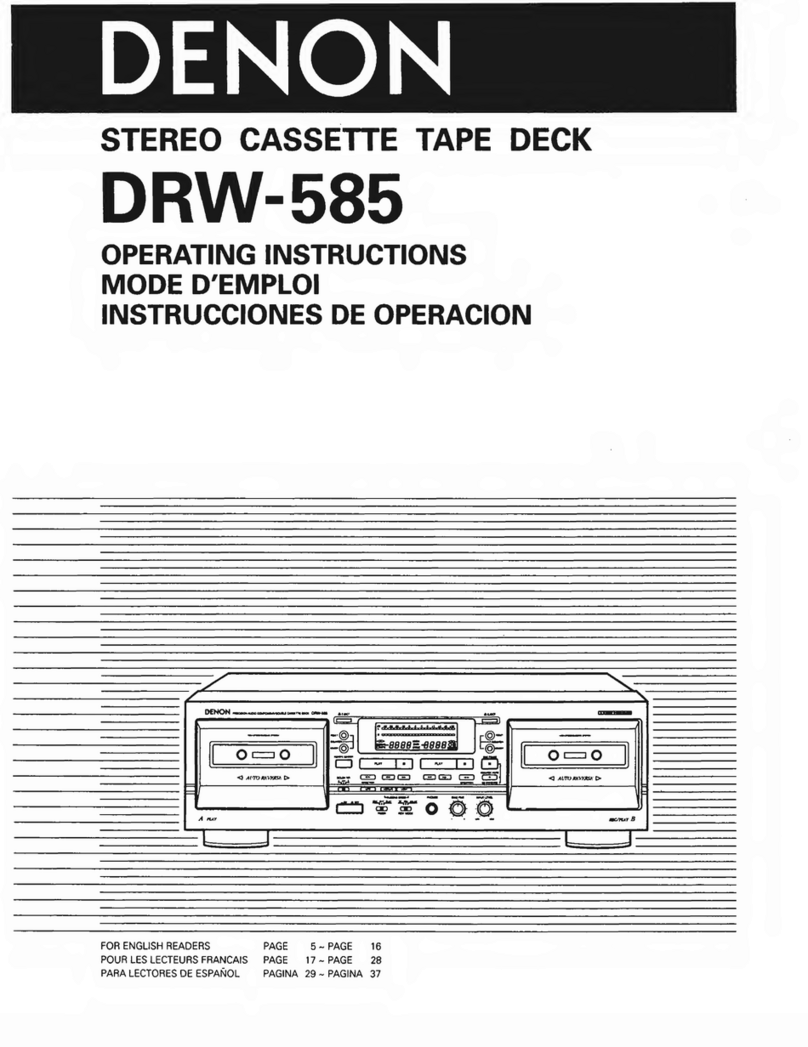
Denon
Denon DRW-585 User manual
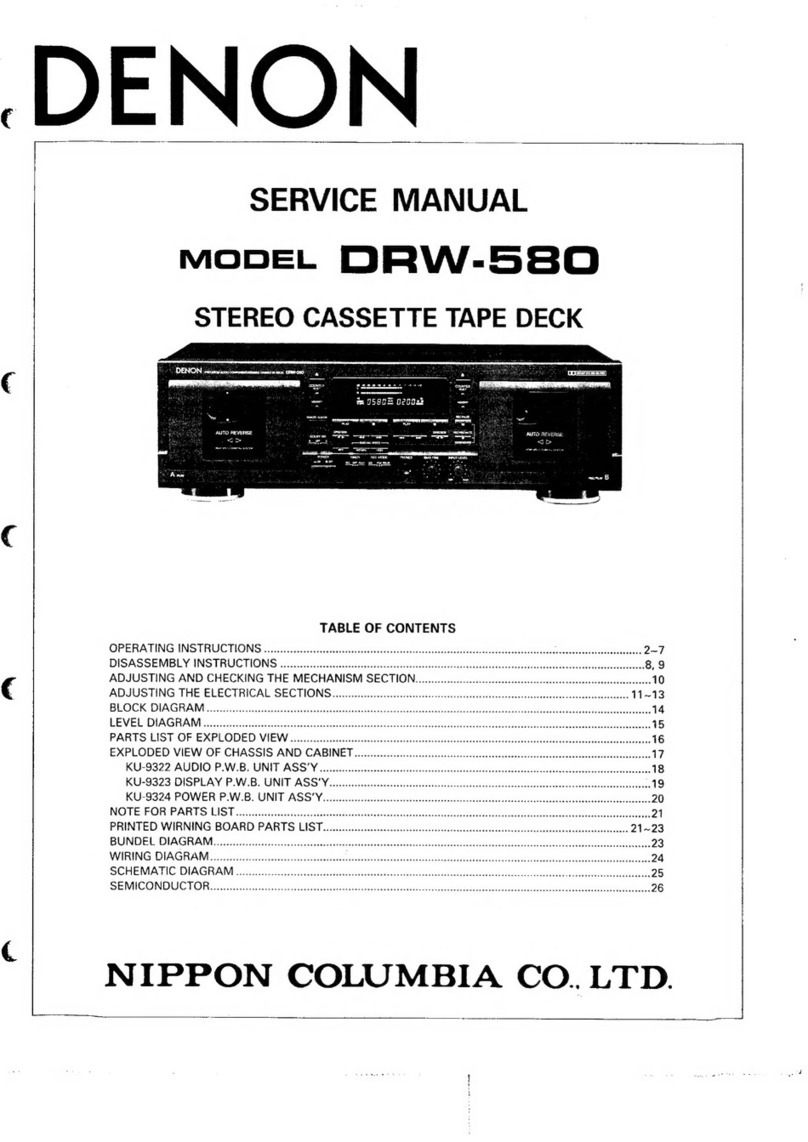
Denon
Denon DRW-5830 User manual
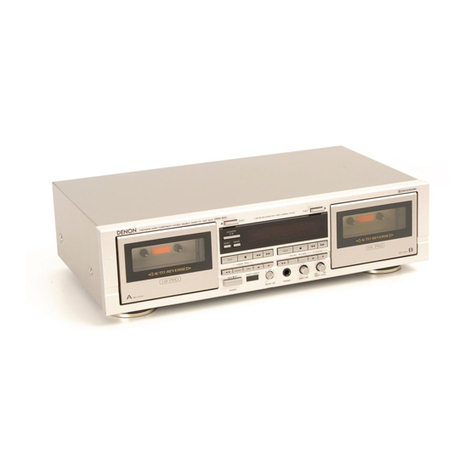
Denon
Denon DRW840 - Stereo Double Cassette Deck User manual

Denon
Denon DR-M2 User manual

Denon
Denon DRW-695 User manual

Denon
Denon DR-M4 User manual

Denon
Denon DRR-M33 User manual

Denon
Denon DRM-400 User manual

